- Wealth Management
- IT Services
- Client Login
- (847) 247-8959


February 27, 2024
How to create a business budget: 8 simple steps.

No matter the size of your business, a business budget is vital to planning and guiding your business’s growth. By understanding the fixed expenses of a company and accounting for the ebb and flow of work, a proper business budget can help your business maintain itself through the year and create protection around unplanned expenses through well allocated funds. In this guide, we'll walk you through the process of creating a business budget, outlining essential steps to help you manage your finances effectively.
What Is a Business Budget?
A business budget is a financial plan outlining projected revenues and expenses for a business during a specific period of time (most typically a year, though there are often monthly or quarterly reexaminations). Although there are variables throughout the year, a complete and accurate budget will serve as a blueprint for businesses in managing income and expenditures, guiding decision-making processes, and ensuring financial stability.
What Should a Business Budget Include?
A comprehensive business budget’s purpose is to provide a business a holistic view of their financial health. When looking through bank statements, take note of those expenses that reoccur throughout the year and note those—as well as those unexpected expenses your company should instead anticipate. Key components to include are:
- Revenue Forecast: Anticipated income from sales, services, or other sources after deducting costs, taxes, and other fees.
- Fixed Operating Expenses: Costs associated with running the business, such as rent, utilities, salaries, and supplies.
- Capital Expenditures: Investments in assets like equipment, machinery, or property.
- Debt Service: Payments towards loans, credit lines, or other forms of debt.
- Taxes: Estimated tax liabilities, including income tax, sales tax, and payroll taxes.
- Contingency Funds: Reserves set aside for unexpected expenses or emergencies.
- Profit Targets: Desired levels of profitability, indicating the financial performance you aim to achieve.
Why Is Budgeting Important to a Business?
Budgeting plays a crucial role in the financial management of a business for several reasons:
- Resource Allocation: Helps allocate resources efficiently to prioritize essential activities and investments.
- Financial Control: Provides a framework for monitoring and controlling expenses to prevent overspending.
- Performance Evaluation: Facilitates performance measurement against predetermined targets, enabling timely corrective actions.
- Decision Making: Guides decision-making processes by providing insights into the financial implications of various options.
- Risk Management: Identifies potential risks and allows for proactive mitigation strategies to safeguard financial stability.

How Does Budgeting Help a Business?
Effective budgeting contributes to the success and sustainability of a business in numerous ways:
- Improved Cash Flow Management: Helps maintain adequate cash reserves to meet financial obligations and fund growth initiatives.
- Enhanced Profitability: Enables businesses to identify opportunities for revenue growth and cost optimization, leading to higher profitability.
- Better Resource Utilization: Ensures optimal utilization of resources by aligning expenditures with strategic priorities and operational needs.
- Increased Financial Transparency: Provides stakeholders with a clear understanding of the company's financial health and performance.
- Long-term Planning: Facilitates long-term planning by forecasting future financial requirements and setting achievable goals.
How to Create a Business Budget
Now that we’ve gone over the importance of a business budget, it’s time to understand the steps you need to take in order to create a comprehensive plan.
Gather Financial Information
Start by compiling relevant financial data, including past income statements, balance sheets, and cash flow statements. Analyze historical trends to identify patterns and make informed projections for the upcoming period.
Determine Your Financial Goals
Define clear, measurable financial goals aligned with your business objectives. Whether it's increasing revenue, reducing costs, or improving profitability, setting specific targets will provide a roadmap for your budgeting process.
Identify Revenue Sources
Identify all potential sources of revenue, including sales, services, investments, and other income streams. Estimate the expected revenue for each source based on market trends, historical data, and sales forecasts.
Estimate Expenses
Next, list all anticipated expenses, categorizing them into fixed and variable costs. Fixed expenses, such as rent and salaries, remain constant regardless of business activity, while variable expenses, like supplies and utilities, fluctuate based on demand.
Factor in Contingencies & Emergency Funds
Allocate a portion of your budget for contingencies and emergency funds to cover unforeseen expenses or revenue shortfalls. Building a financial cushion will provide stability and resilience during challenging times.
Balance Your Budget
Balance your budget by ensuring that projected revenues exceed estimated expenses. If there's a deficit, identify areas where you can reduce costs or increase revenue to achieve equilibrium.
Monitor & Track Your Budget
Regularly monitor and track your budget against actual financial performance to identify variances and deviations. Use accounting software or spreadsheets to update your budget and make adjustments as needed to stay on course.
Review & Adjust Budget Regularly
Review your budget periodically, ideally on a quarterly or annual basis, to assess its effectiveness and relevance. Adjust your budget as necessary based on changing market conditions, business priorities, and performance trends.
Contact Mowery & Schoenfeld for Help with Business Budgeting
Creating and managing a business budget requires expertise and strategic planning. At Mowery & Schoenfeld, we specialize in helping businesses develop robust financial strategies to achieve their financial goals. Contact us today to learn how our team of experienced professionals can assist you with business budgeting and financial management.
What is Budgeting?
Translating strategy into targets and budgets, goals of the budgeting process, types of budgets, the process, additional resources.
The tactical implementation of a business plan
Budgeting is the tactical implementation of a business plan. To achieve the goals in a business’s strategic plan , we need a detailed descriptive roadmap of the business plan that sets measures and indicators of performance. We can then make changes along the way to ensure that we arrive at the desired goals.
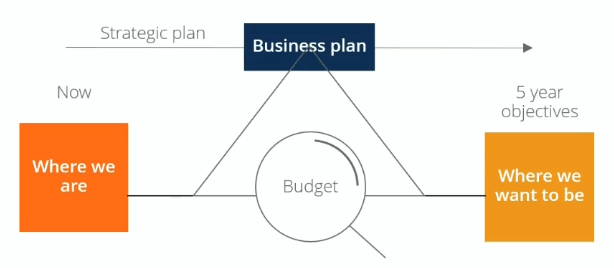
There are four dimensions to consider when translating high-level strategy, such as mission, vision, and goals, into budgets.
- Objectives are basically your goals, e.g., increasing the amount each customer spends at your retail store.
- Then, you develop one or more strategies to achieve your goals. The company can increase customer spending by expanding product offerings, sourcing new suppliers, promotion , etc.
- You need to track and evaluate the effectiveness of the strategies, using relevant measures . For example, you can measure the average weekly spending per customer and average price changes as inputs.
- Finally, you should set targets that you would like to reach by the end of a certain period. The targets should be quantifiable and time-based , such as an increase in the volume of sales or an increase in the number of products sold by a certain time.

Budgeting is a critical process for any business in several ways.
1. Aids in the planning of actual operations
The process gets managers to consider how conditions may change and what steps they need to take, while also allowing managers to understand how to address problems when they arise.
2. Coordinates the activities of the organization
Budgeting encourages managers to build relationships with the other parts of the operation and understand how the various departments and teams interact with each other and how they all support the overall organization.
3. Communicating plans to various managers
Communicating plans to managers is an important social aspect of the process, which ensures that everyone gets a clear understanding of how they support the organization. It encourages communication of individual goals, plans, and initiatives, which all roll up together to support the growth of the business. It also ensures appropriate individuals are made accountable for implementing the budget.
4. Motivates managers to strive to achieve the budget goals
Budgeting gets managers to focus on participation in the budget process. It provides a challenge or target for individuals and managers by linking their compensation and performance relative to the budget.
5. Control activities
Managers can compare actual spending with the budget to control financial activities.
6. Evaluate the performance of managers
Budgeting provides a means of informing managers of how well they are performing in meeting targets they have set.
A robust budget framework is built around a master budget consisting of operating budgets, capital expenditure budgets, and cash budgets. The combined budgets generate a budgeted income statement, balance sheet, and cash flow statement.
1. Operating budget
Revenues and associated expenses in day-to-day operations are budgeted in detail and are divided into major categories such as revenues, salaries, benefits, and non-salary expenses.
2. Capital budget
Capital budgets are typically requests for purchases of large assets such as property, equipment, or IT systems that create major demands on an organization’s cash flow. The purposes of capital budgets are to allocate funds, control risks in decision-making, and set priorities.
3. Cash budget
Cash budgets tie the other two budgets together and take into account the timing of payments and the timing of receipt of cash from revenues. Cash budgets help management track and manage the company’s cash flow effectively by assessing whether additional capital is required, whether the company needs to raise money, or if there is excess capital.
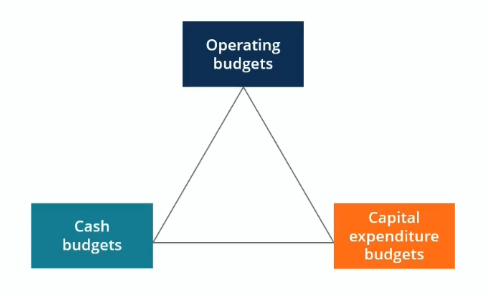
The budgeting process for most large companies usually begins four to six months before the start of the financial year, while some may take an entire fiscal year to complete. Most organizations set budgets and undertake variance analysis on a monthly basis.
Starting from the initial planning stage, the company goes through a series of stages to finally implement the budget. Common processes include communication within executive management, establishing objectives and targets, developing a detailed budget, compilation and revision of budget model, budget committee review, and approval.
Budget Head
Operating Budget
Projecting Balance Sheet Items
See all FP&A resources
- Share this article

Create a free account to unlock this Template
Access and download collection of free Templates to help power your productivity and performance.
Already have an account? Log in
Supercharge your skills with Premium Templates
Take your learning and productivity to the next level with our Premium Templates.
Upgrading to a paid membership gives you access to our extensive collection of plug-and-play Templates designed to power your performance—as well as CFI's full course catalog and accredited Certification Programs.
Already have a Self-Study or Full-Immersion membership? Log in
Access Exclusive Templates
Gain unlimited access to more than 250 productivity Templates, CFI's full course catalog and accredited Certification Programs, hundreds of resources, expert reviews and support, the chance to work with real-world finance and research tools, and more.
Already have a Full-Immersion membership? Log in

A How-To Guide for Creating a Business Budget
Amanda Smith
Reviewed by
September 23, 2022
This article is Tax Professional approved
Most business owners know how important a business budget is when it comes to managing expenses and planning for the future—but in a challenging economic environment like the one we’ve been experiencing, your business budget takes on even greater significance.
With inflation running rampant and the possibility of a recession looming, business owners need to be able to forecast their cash flow, manage their expenses, and plan for the future. Creating a detailed business budget is the first step.
Whether you want to revamp your budgeting method, or you’ve never created a business budget before, this guide will walk you through the process.
I am the text that will be copied.
What is a business budget?
A budget is a detailed plan that outlines where you’ll spend your money monthly or annually.
You give every dollar a “job,” based on what you think is the best use of your business funds, and then go back and compare your plan with reality to see how you did.
A budget will help you:
- Forecast what money you expect to earn
- Plan where to spend that revenue
- See the difference between your plan and reality
What makes a good budget?
The best budgets are simple and flexible. If circumstances change (as they do), your budget can flex to give you a clear picture of where you stand at all times.
Every good budget should include seven components:
1. Your estimated revenue
This is the amount you expect to make from the sale of goods or services. It’s all of the cash you bring in the door, regardless of what you spent to get there. This is the first line on your budget. It can be based on last year’s numbers or (if you’re a startup ), based on industry averages.
2. Your fixed costs
These are all your regular, consistent costs that don’t change according to how much you make—things like rent, insurance, utilities, bank fees, accounting and legal services, and equipment leasing.
Further reading: Fixed Costs (Everything You Need to Know)
3. Your variable costs
These change according to production or sales volume and are closely related to “ costs of goods sold ,” i.e., anything related to the production or purchase of the product your business sells. Variable costs might include raw materials, inventory, production costs, packaging, or shipping. Other variable costs can include sales commission, credit card fees, and travel. A clear budget plan outlines what you expect to spend on all these costs.
The cost of salaries can fall under both fixed and variable costs. For example, your core in-house team is usually associated with fixed costs, while production or manufacturing teams—anything related to the production of goods—are treated as variable costs. Make sure you file your different salary costs in the correct area of your budget.
Further reading: Variable Costs (A Simple Guide)
4. Your one-off costs
One-off costs fall outside the usual work your business does. These are startup costs like moving offices, equipment, furniture, and software, as well as other costs related to launch and research.
5. Your cash flow
Cash flow is all money traveling into and out of a business. You have positive cash flow if there is more money coming into your business over a set period of time than going out. This is most easily calculated by subtracting the amount of money available at the beginning of a set period of time and at the end.
Since cash flow is the oxygen of every business, make sure you monitor this weekly, or at least monthly. You could be raking it in and still not have enough money on hand to pay your suppliers.
6. Your profit
Profit is what you take home after deducting your expenses from your revenue. Growing profits mean a growing business. Here you’ll plan out how much profit you plan to make based on your projected revenue, expenses, and cost of goods sold. If the difference between revenue and expenses (aka “ profit margins ”) aren’t where you’d like them to be, you need to rethink your cost of goods sold and consider raising prices .
Or, if you think you can’t squeeze any more profit margin out of your business, consider boosting the Advertising and Promotions line in your budget to increase total sales.
7. A budget calculator
A budget calculator can help you see exactly where you stand when it comes to your business budget planning. It might sound obvious, but getting all the numbers in your budget in one easy-to-read summary is really helpful.
In your spreadsheet, create a summary page with a row for each of the budget categories above. This is the framework of your basic budget. Then, next to each category, list the total amount you’ve budgeted. Finally, create another column to the right—when the time period ends, use it to record the actual amounts spent in each category. This gives you a snapshot of your budget that’s easy to find without diving into layers of crowded spreadsheets.
See the sample below.
| Income | Budget | Actual | Under/Over |
|---|---|---|---|
| Sales - Product 1 | $25,000 | $22,000 | -$3,000 |
| Sales - Product 2 | $34,000 | $36,000 | +$2,000 |
| Revenue - Coaching | $9,000 | $8,900 | $-100 |
| Revenue - Sublease | $13,000 | $13,000 | $0 |
| Total | $81,000 | $79,900 | -$1,100 |
| Expenses | Budget | Actual | Under/Over |
|---|---|---|---|
| Cost of Goods Sold | $12,000 | $13,243 | +$1,243 |
| Rent | $36,000 | $36,000 | $0 |
| Wages | $15,423 | $15,200 | -$223 |
| Office Move | $3,000 | $3,300 | -$300 |
| Total | $66,423 | $67,743 | +$720 |
| Profit | Budget | Actual | Under/Over |
|---|---|---|---|
| Total | $14,577 | $12,157 | $2,420 |
Pro tip: link the totals on the summary page to the original sums in your other budget tabs . That way when you update any figures, your budget summary gets updated at the same time. The result: your very own budget calculator.
You can also check out this simple Startup Cost Calculator from CardConnect. It lays out some of the most common expenses that you might not have considered. From there, you can customize a rough budget for your own industry.
Small business budgets for different types of company
While every good budget has the same framework, you’ll need to think about the unique budgeting quirks of your industry and business type.
Seasonal businesses
If your business has a busy season and a slow season, budgeting is doubly important.
Because your business isn’t consistent each month, a budget gives you a good view of past and present data to predict future cash flow . Forecasting in this way helps you spot annual trends, see how much money you need to get you through the slow months, and look for opportunities to cut costs to offset the low season. You can use your slow season to plan for the next year, negotiate with vendors, and build customer loyalty through engagement.
Don’t assume the same thing will happen every year, though. Just like any budget, forecasting is a process that evolves. So start with what you know, and if you don’t know something—like what kind of unexpected costs might pop up next quarter— just give it your best guess . Better to set aside money for an emergency that doesn’t happen than to be blindsided.
Ecommerce businesses
The main budgeting factor for ecommerce is shipping. Shipping costs (and potential import duties) can have a huge impact.
Do you have space in your budget to cover shipping to customers? If not, do you have an alternative strategy that’s in line with your budget—like flat rate shipping or real-time shipping quotes for customers? Packaging can affect shipping rates, so factor that into your cost of goods sold too. While you’re at it, consider any international warehousing costs and duties.
You’ll also want to create the best online shopping experience for your customers, so make sure you include a good web hosting service, web design, product photography, advertising, blogging, and social media in your budget.
Inventory businesses
If you need to stock up on inventory to meet demand, factor this into your cost of goods sold. Use the previous year’s sales or industry benchmarks to take a best guess at the amount of inventory you need. A little upfront research will help ensure you’re getting the best prices from your vendors and shipping the right amount to satisfy need, mitigate shipping costs, and fit within your budget.
The volume of inventory might affect your pricing. For example, if you order more stock, your cost per unit will be lower, but your overall spend will be higher. Make sure this is factored into your budget and pricing, and that the volume ordered isn’t greater than actual product demand.
You may also need to include the cost of storage solutions or disposal of leftover stock.
Custom order businesses
When creating custom ordered goods, factor in labor time and cost of operations and materials. These vary from order to order, so make an average estimate.
Budgeting is tricky for startups—you rarely have an existing model to use. Do your due diligence by researching industry benchmarks for salaries, rent, and marketing costs. Ask your network what you can expect to pay for professional fees, benefits, and equipment. Set aside a portion of your budget for advisors—accountants, lawyers, that kind of thing. A few thousand dollars upfront could save you thousands more in legal fees and inefficiencies later on.
This is just scratching the surface, and there’s plenty more to consider when creating a budget for a startup. This business startup budget guide from The Balance is a great start.
Service businesses
If you don’t have a physical product, focus on projected sales, revenue, salaries, and consultant costs. Figures in these industries—whether accounting, legal services, creative, or insurance—can vary greatly, which means budgets need flexibility. These figures are reliant on the number of people required to provide the service, the cost of their time, and fluctuating customer demand.
Small business budgeting templates
A business budget template can be as simple as a table or as complex as a multi-page spreadsheet. Just make sure you’re creating something that you’ll actually use.
Create your budget yearly—a 12-month budget is standard fare—with quarterly or monthly updates and check-ins to ensure you’re on track.
Here are some of our favorite templates for you to plug into and get rolling.
- The Balance has a clear table template that lists every budget item, the budgeted amount, the actual amount, and the difference between the two. Use this one if you’re looking to keep it simple.
- Capterra has both monthly and annual breakdowns in their Excel download. It’s straightforward, thorough, and fairly foolproof.
- Google Sheets has plenty of budget templates hiding right under your nose. They’re easy to use, and they translate your figures into clear tables and charts on a concise, visual summary page.
- Smartsheet has multiple resources for small businesses, including 12-month budget spreadsheets, department budget templates, projection templates, project-by-project templates, and startup templates. These templates are ideal if you’re looking for a little more detail.
- Scott’s Marketplace is a blog for small businesses. Their budget template comes with step-by-step instructions that make it dead simple for anyone.
- Vertex42 focuses on Excel spreadsheets and offers templates for both product-based and service-based businesses, as well as a business startup costs template for anyone launching a new business.
Budgeting + bookkeeping = a match made in heaven
Making a budget is kind of like dreaming: it’s mostly pretend. But when you can start pulling on accurate historical financials to plan the upcoming year, and when you can check your budget against real numbers, that’s when budgets start to become useful.
The only way to get accurate financial data is through consistent bookkeeping.
Don’t have a regular bookkeeping process down pat? Check out our free guide, Bookkeeping Basics for Entrepreneurs . We’ll walk you through everything you need to know to get going yourself, for free.
If you need a bit more help, get in touch with us. Bookkeeping isn’t for everyone, especially when you’re also trying to stay on top of a growing business—but at Bench, bookkeeping is what we do best.
Related Posts

Statement of Retained Earnings: A Complete Guide
Understanding the statement of retained earnings can help you evaluate your business’s profitability and help you plan for future growth.

The Top Trucking Accounting Software
Find the best trucking accounting software for your business with our comparison guide. Read about features, pricing, and more to make the best decision for your company.

Form 1099-K and Ecommerce Merchant Fees
Have an ecommerce business? Here’s what you need to know about merchant fees and Form 1099-K.
Join over 140,000 fellow entrepreneurs who receive expert advice for their small business finances
Get a regular dose of educational guides and resources curated from the experts at Bench to help you confidently make the right decisions to grow your business. No spam. Unsubscribe at any time.

The Ultimate Guide to Budgeting for Small Businesses
By Andy Marker | March 4, 2022
- Share on Facebook
- Share on LinkedIn
Link copied
Creating a budget for your small business can be daunting, but doing so is essential for any successful company. We’ve rounded up expert tips and created a step-by-step guide for designing a strong small business budget.
Included on this page, you’ll learn why a budget is necessary for small businesses and how to create a budget using Excel . Plus, you’ll find a free, downloadable small business budget starter kit .
What Is a Small Business Budget?
A small business budget is a detailed outline of your financial status and projection, based on your historical financial data. It includes your projected income and expenses and is used to determine where your money is best spent.

Ahmet Yüzbaşıoğlu, the Co-Founder of Peak Plans , explains the importance of budgeting for small businesses: “The success of your business is determined by the quality of your decisions. If you want to make informed decisions, you must have a budget. A budget can help you create a plan for the future, whether it's for your company as a whole or for smaller departments. More importantly, [a budget] gives you guidelines with which to make decisions. If budgeting is not yet a part of your business strategy, it may be worth considering it as an option to provide you with insights that can help you to better plan for all aspects of your company.”
Do Small Businesses Need a Budget?
All businesses should have a budget, especially small ones with less room for errors. A small business can better weather periods of low income by knowing exactly where its money is going, forecasting sales, and identifying what can be cut when needed.

Stephen Light, the Co-Owner of Nolah Mattress , gives his take on why all small businesses should have a budget in place: “For small businesses, creating an effective budget is one of the most important tools to carve a successful path to profitability. Budgets are crucial for allocating funds efficiently and curbing any unnecessary or wasteful spending, [which is] an easy trap to fall into if you don’t have a framework or goalposts to stay within. Budgets are especially important to small business owners who might be using their personal funds.”
How Much Should a Small Business Budget Be?
Your budget should be based on historical financial data and not exceed what you expect to make in the budgeted period. Be realistic with your numbers and projections so that you do not find yourself in a position you cannot recover from.
Your budget should take into account all of your sources of revenue and all of your expenses, as well as an additional percentage for any emergencies or surprises.
“Small businesses should absolutely be sure to pad their budget with contingency funds for unseen expenses,” suggests Light.
Larger businesses tend to make budgets annually , but for a small business, especially at first, it is a good idea to break down your budget monthly. To get started and identify a realistic monthly budget for your business check out our small business monthly budget templates for Google Sheets.
Importance of Budgeting in a Small Business
A budget helps a small business anticipate challenges, achieve and track financial targets, and secure investment opportunities. A well-considered budget should help a small business to encounter fewer unforeseen expenses and more opportunities.
Below are some benefits of having a strong budget:
- Make Informed Decisions: A company can make more informed decisions more efficiently when they have a budget. A good budget is built on historical data and allows you to learn from your experience. “Budgeting is a great strategy for maintaining informed control of your business. You can use data insights to plan with greater clarity and organize all of your finances in one place. This allows your leadership team to have the necessary information to drive their decision-making processes more efficiently, which is a great way for your business to act on its data,” explains Yüzbaşıoğlu.
- Identify Growth Opportunities: With a budget in place, you can identify the most profitable projects for your company. Use your budget data over time to see where current resource allocation provides the most payoff. As Yüzbaşıoğlu says, “You can use budgeting to create assumptions about your business projections by measuring the effects of different investments on your business. For example, you can make conclusions about how much revenue an investment in sales will bring in with the information gathered from your marketing efforts. By evaluating different scenarios, you can consider your options for best achieving your goals. Observing different scenarios will soon help you find which strategies work best for your business.”
- Weather Leaner Business Times: All businesses should expect to encounter lean times. Having a budget in place can help you stay afloat by tracking which times are historically slow and by establishing an emergency fund. Knowing when to spend your money can be just as important as what you spend it on.

- Manage Risk: A well-crafted budget can help you to identify potential risks by gaining visibility into your spending. If you don’t track your money, it is easy to spend much more than you had planned (on an unsound investment). “Looking ahead is important for risk management ,” says Yüzbaşıoğlu. “Budgeting is a good way of looking ahead and contains similar methodologies as risk management. A budget allows you to look ahead and see how your activities in different areas will affect the company’s cash flow, earnings, and profitability.”
- Measure Performance: Having access to current and historical financial data from your business allows you to measure financial performance year over year. Without tracking this information, you cannot know which goals you are meeting. “Budgets are the most important tools that managers use to measure how well an organization is doing. Although budgets are commonly perceived to exist for financial purposes only, they can also be key tools to provide insight into how an organization and its departments are performing. Identifying variances — such as differences in expenses and costs and increase or decrease in sales and profits — will give a good overview to management about the performance of the company and its departments,” explains Yüzbaşıoğlu.
- Set Company Goals: A budget is a great place to start goal setting. Whether you aim to spend less over time or drive more sales, a budget gives you concrete numbers on which to base your financial goals. “When all parties are on the same page about the strategic goals of the company and the means of attaining them, it is much simpler to monitor success and work together to keep the organization on track to achieve its goals,” suggests Mains.
What Should a Small Business Budget Include?
A small business budget should include all income and expenses the business accrues over a given period. These numbers may change month to month, so it is important to either use an average, or to overestimate expenses and underestimate income.

Linn Atiyeh, the CEO and Founder of Bemana , highlights some major small business budget expenses that may not be immediately obvious. “[The expenses] need to include everything, from the employees themselves to the office spaces that they work in. They need to include technology, software, onboarding, training, client acquisition, insurance payments, marketing, product development, employee compensation, and any other anticipated costs,” she says.
The following bullets outline what to include in your budget:
- All Income and Expenses: Your budget should consider the entirety of your income and expenses. Note fixed and variable costs. It may also be beneficial to keep track of which expenses you can easily cut during lean times.
- Small Business Financial Plan: When creating your budget, consult your financial plan. If you do not have one, create an income statement and a cash flow statement . “You must incorporate your cash flow in your projections. Cash flow refers to the total amount of money that flows into and out of a firm. If you have positive cash flow in your firm over a certain period of time, this means that more money is flowing into your business than is leaving it,” says Mains. To learn more, read our how-to guide on creating a small business financial plan.
- Historical Sales Numbers: If you have them, use your historical sales numbers to project your income during the same time period in the future. If you don’t have historical data, start tracking it. As you continue to track this information, you will get a better idea of how much money your company is making and spending at different times of the year.
- Sales Forecasts: Create a sales forecast and use it to estimate your projected income. This information will help give you a target number for your budget.
- Emergency Fund: Any strong budget will include some wiggle room for emergencies and surprise expenses. Most sources recommend keeping three to six months’ worth of business expenses in an emergency fund — but remember that some money saved is better than none at all.
- Seasonal and Industry Trend Information: Most industries have slow seasons and busy seasons, and it is important to know when those times are. If you don’t have this information from your own business, a quick Google search can often tell you the answer.
- Growth Projections: Factor any expectations for major growth into your budget, such as opening a new storefront, buying new equipment, or hiring and training a new department.
How to Create a Budget for a Small Business
To create a budget for your small business, determine how much money your company spends and makes, and estimate how it will do so in the future. We’ve outlined how to create a budget in the steps below:
1. Gather Your Financial Information
This includes all income and expense information from previous years and any previous budget information you may have.

“To begin with, collect financial data, predictions, and market analysis to aid in the development of your small company's budget planning,” suggests Lattice Hudson, Business Coach and Owner of Lattice and Co . “To design your budget, consider the company's overall business and overall strategy in addition to the crucial financial data and analytics.”
2. Add Up Your Income
Use a small business budget template or spreadsheet to itemize and add up your income. Consider using a tool that tracks itemized income monthly so that you can more easily note changes over time.
3. Subtract Fixed Costs
Your fixed costs won’t change month to month, so they are the easiest to subtract from your income. Fixed costs might include rent, salaried employees, and non-variable utilities.
4. Determine and Subtract Variable Expenses
Not all costs are fixed, so you may need to do a little digging to determine some of your expenses. Calculate how much the company spent on hourly employees, variable utilities, and break room snacks and business lunches.
“Variable costs are those that change from month to month depending on your company's success, [such as] consumption-based utilities, delivery charges, transport costs, and sales commissions. When your earnings are greater, you may spend more on variable costs, but when your earnings are lower, you should aim to cut back where you can,” says Hudson.
5. Profit and Loss Statement
Prepare a profit and loss statement from the data you’ve collected. Outline how much your company made and spent in a given time period. This will be the first indicator of what your budget numbers should look like.
6. Outline a Forward-Looking Budget
Create your budget using the numbers from historical profit and loss statements. Your income and expenses may grow or shrink over time, so it is important to calculate an average or to add a buffer to your expenses. Your budget should always have money left over for incidentals, as well as allocation to an emergency fund.
Hays Bailey, the CEO and Founder of Sheqsy , recommends that you also include allocations for expansions or growth if you can see either on the horizon.
7. Review on a Schedule
Review your budget periodically. Track your income and expenses monthly, and update your budget as things change. “Over time, you will gain a better understanding of your company's operations and will be able to make more informed decisions regarding your budgeting plan,” says Hudson.
How to Create a Small Business Budget Spreadsheet in Excel
Microsoft Excel makes it easy to organize and chart your small business budget over time. The following tutorial lays out step by step how to use a template in Excel to add up your income and expenses and determine your business’s cash flow.
Gather and Organize All Relevant Financial Information for Your Business
To start your budget, you will need to gather and organize all of your financial information for the previous period. This includes income statements, expense reports, cash flow documentation, and any other relevant documents. If this is your first budget and you do not have these items, organize your bank statements, invoices, payroll information, and receipts.
By organizing your data into these documents, each month becomes easier to track than the last. The more you stay organized, the simpler it will be to maintain your budget.
Download a Small Business Budget Template
- Download the small business budget template for Microsoft Excel.

Record Your Monthly Income
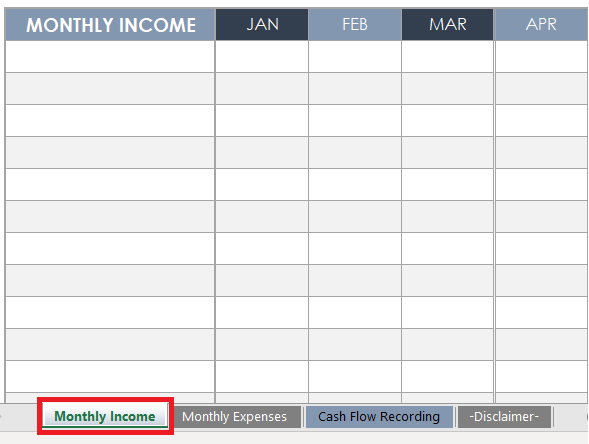
Record Your Monthly Expenses
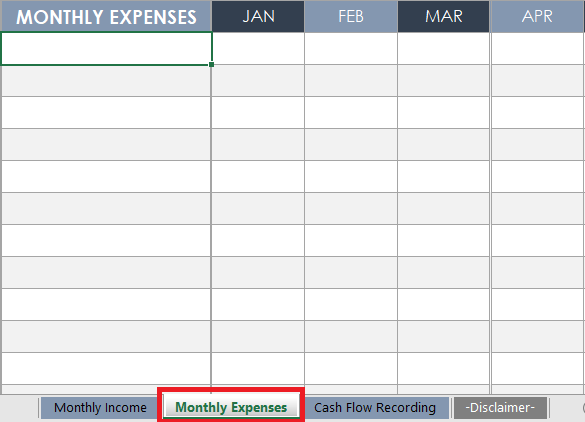
Record Your Cash Flow
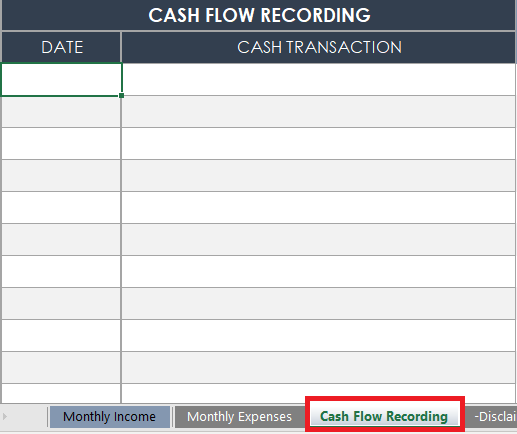
Save and Update Your Budget Regularly
Store your budget template on an accessible drive and update it regularly. Small businesses should update their budget and cash flow as often as possible to stay up to date.
Small Business Budget Example
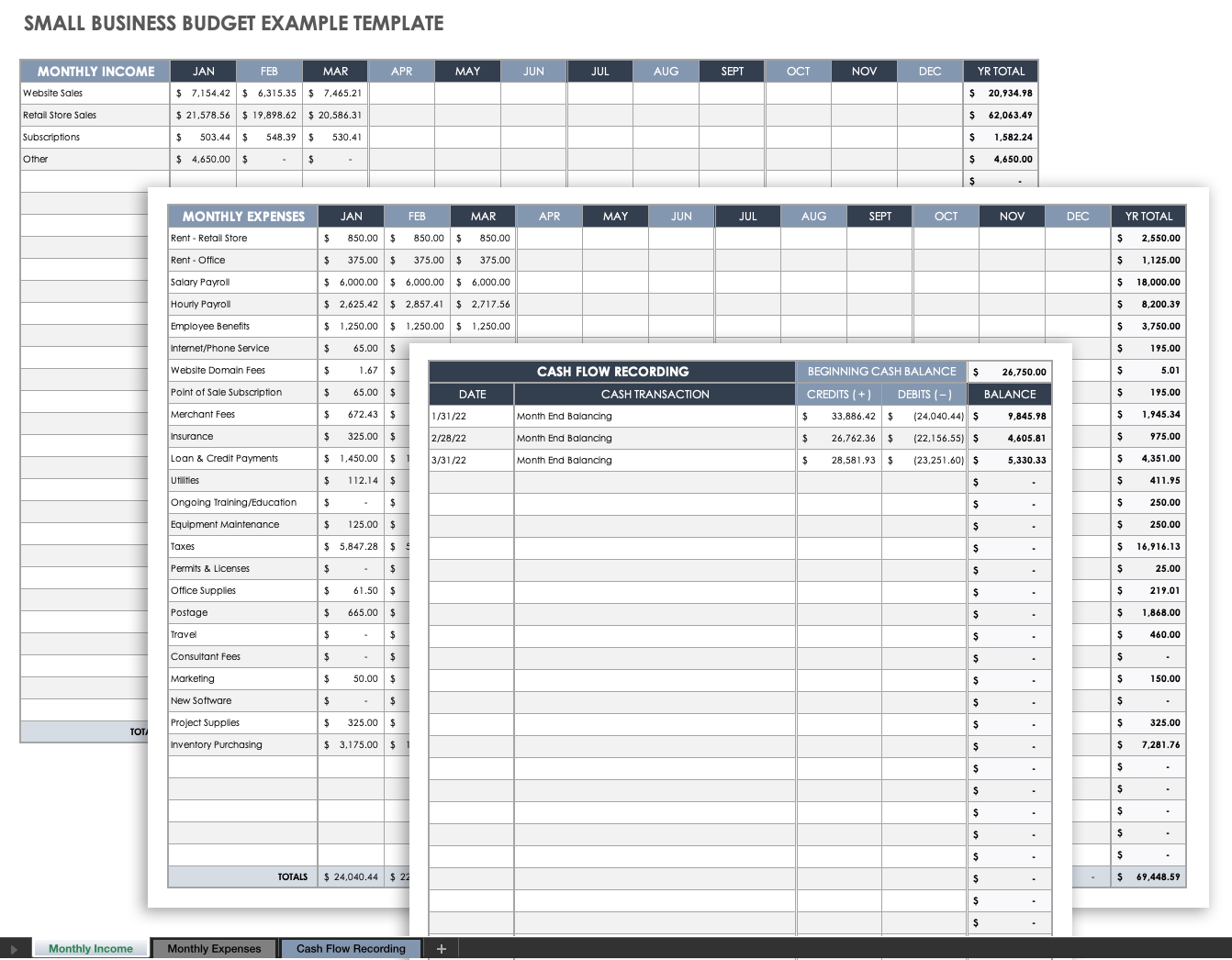
Download Small Business Budget Example Microsoft Excel | Google Sheets
In this example of a small business budget, we’ve listed sample income, expense, and cash flow information using categories that are relevant to a small retail business. This template is fully customizable and can be used for a small business in any industry. You can also download a blank version of this template in the small business budget starter kit below.
Tips for Creating a Small Business Budget
Creating a budget for your small business can be daunting. To help you get started, we’ve gathered expert tips, from finding a mentor to setting realistic goals.
- Be Realistic: Keep all financial estimates in the realm of reality. Use historical financial data from your own past whenever possible. “My best tip is to avoid any wishful thinking or dreaming about best-case scenarios because it’s always better to use the real data from years past and to be realistic — you’ll avoid disappointment and tricky financial situations that way,” suggests Light.
- Note Changing Costs: Products and services don’t always cost the same amount every year. Be sure that the expenses listed in your budget are accurate at all times. “Be very mindful of the rapid rate at which prices can change and to get as many quotes as possible to inform your budget,” says Atiyeh. “On the first of these points, you may incorrectly assume that the amount you paid for a service in the past is still a good indicator of how much it would cost today. However, services are priced based on a multitude of factors, such as demand and market circumstances. Keep this in mind when creating a budget.”
- Find a Mentor: Doing so can cut down on the time it might take you to learn about business budgeting on your own. “Find someone who has experience in making budgets. Making a budget is technical and it requires experience if you want it to be done right. Of course, you are also allowed to do it on your own, but expect that it is going to take time and that you are in for lots of revisions,” warns Bailey.
- Overestimate Your Costs: Overestimating your costs helps ensure that your finances aren’t threatened when surprises come up or projects go over budget. You will be much better equipped to weather financial hardship if you’ve made room in your budget to respond to unexpected changes. “If your company works on a project-by-project basis, you are well aware that every customer is unique and no two projects will be precisely the same in their outcome. It is often impossible to forecast when a project may run over budget,” says Mains. “So much of running a company is about anticipating and responding to the unexpected. For small company owners, failure to predict an expenditure or its scale may be devastating and may cause the organization to become crippled before it has had a chance to mature and develop. Company owners must overestimate their costs to protect themselves from financial risk. This is a survival strategy that will assist business owners to protect themselves against danger and failure.”

What Specific Types of Businesses Should Consider when Budgeting for a Small Business
Budgeting for any business involves adding up income, subtracting expenses, and identifying where to spend and save money. Because different industries require different strategies, we’ve created a list of things to consider for specific small business types.

“One thing that is unique to small businesses as a whole is that there are so many different types of businesses. This means that there is no one-size-fits-all budget plan for small businesses. Each business should tailor its budget plan to its own specific needs and circumstances,” explains Lindsey Hyland, Founder of Urban Organic Yield .
- Seasonal Businesses: Some small businesses, such as those based around holidays or gardening, operate at a much higher business volume at certain times of the year. These businesses need to consider that their busy season will bring in much more income than their slow season(s). One way to tackle this is to take an average of your monthly income for the year and use that as your monthly operating budget. Don’t project based on the biggest numbers — use the smaller numbers or an average. For these businesses, it is especially important to establish an emergency fund so that a surprise expense during the slow season doesn’t become a catastrophe.
- Recruitment and Staffing: Businesses that deal with recruitment and staffing need to have a finger on the pulse of the businesses they work with. Do outside research into the growth or downscaling of other businesses to determine budget numbers for a given period. “Since my company is in the industrial and equipment recruiting industry, one unique challenge that we face is having to incorporate the needs of other businesses into our budget. For instance, it's important that we stay mindful of how much these businesses are upscaling or downscaling their operations at any given time, as that directly impacts the provision of our services,” says Atiyeh.
- E-commerce: Online businesses may have fewer fixed costs, such as rent, but may have more variable ones. Shipping costs, shipping zones, import taxes, and shipping supplies will change based on sales volume, so find an average or inflated number that works for these budget items. Companies that operate exclusively online should also invest in a well-made, working website and have a system in place for potential returns. These two things will help improve remote customer service, which can lead to more sales — and a larger budget — in the future.
- Nonprofits: Not-for-profit businesses are funded in a variety of ways, including through grants, donations, and dues. For these businesses, it is even more important to keep the budget as realistic as possible at all times, as there is commonly less money to move around. For more information and to help keep your budget balanced, peruse our list of free nonprofit budget templates .
- Inventory Business: Remember that it can be very expensive to keep large amounts of inventory on hand. Buying more of a product to sell can sometimes be cheaper because of the economy of scale, but ensure you have the space and capacity to hold on to things that don’t sell right away. Consider that you may need to spend more on rent and temperature control for a place to store these items.
- Custom Orders: The price of a custom order is not only the cost of the finished product, but a combination of factors. Determine a cost for your time and labor for conception, execution, materials, and delivery, and factor those into your expenses.
- Startups: Budgeting for a company with no existing financial history can be tough. Company owners will need to do research on the industry and use those numbers to create a rough estimate for their budget. When you are estimating a budget from scratch, be sure to overestimate your costs to mitigate risks. It is always a good idea to ask professionals and people with experience. Visit this list of free customizable startup budget templates to get started.
- Construction: Construction companies need to factor in the cost of all associated permits and insurance on top of all of the general costs of doing business. Permits and insurances may change based on the specific job you are doing, so it is critical to factor those costs into the relevant monthly budget. To help keep you organized, check out this list of free construction budget templates .
- Service: Businesses based on service need to put a larger portion of their budget toward staff training and retention. Better employees mean better service, and much of an employee's ability comes from their training. Additionally, you do not want to lose the valuable employees you spend time and money training, so these businesses need to factor in rising pay scales for more qualified staff.
- All Small Businesses: Do not forget to factor in taxes and fees involved in running your business. If you don’t know what they are, ask a professional for help. “There are a shocking number of people that do not make any self-employment tax payments to the IRS for lack of fear or know-how,” says Stevenson.
How to Manage a Small Business Budget
Manage your small business budget by spending within your means and saving money where you can. Make sure your budget is as realistic as possible, and update and revise it on a regular basis.
- Spend Within Your Means: Whenever possible, do not spend more money than you make. Use loans and credit wisely so as not to dig yourself into a hole. “Make do with what you have, start small with the free versions of software before you upgrade. Save for equipment. Make room in the budget later if you can’t afford it now,” advises Stevenson.
- Get Multiple Quotes: When you work with other businesses, it is in your best interest to get multiple quotes. You can use these quotes to negotiate the prices of goods or services that you need to run your own business, and save money in your budget. “By getting as many quotes as possible, you can build a more accurate understanding of the true prices of what you'll need throughout the period of time that you're budgeting for. By getting quotes from several sources rather than just one or two, you can make sure that your estimates are fair and accurate,” suggests Atiyeh.
- Revisit Your Budget Regularly: Circumstances can easily change from month to month or year to year. “The best way to stay on budget is to revisit the budget regularly. Budgets shouldn’t be set and then put away, they should be consistently reassessed and adjusted. If you’re committed to tweaking and allowing your budget to evolve with a watchful eye, you’re far more likely to stay within its bounds,” says Light.
- Be Realistic from the Outset: It is easy to get carried away with lofty goals and underestimated expenses. The closer your budget reflects reality, the easier it will be to stick to the plan. “Don’t underestimate expenses just to make your budget look conservative, because a budget that’s unrealistic is so much worse than not having a budget at all. It is misleading and it can cause lots of problems in the long run,” warns Bailey.
How to Do a Small Business Budget Efficiently
There are three key ways to help ensure that you manage your small business’s budget efficiently: Use the tools that are available to you, review your financial data on a schedule, and seek help when you need it.
- Use Software Tools: There are many software tools that can help you to create a budget. Many offer free trials so that you can find the one that works best for you. You may also find that a template suits your needs.
- Hire Help: Consider using the professional services of a financial advisor, or hire an accountant to manage your budget. For many businesses, hiring someone to manage the money is an inevitability that should be considered sooner than later.
- Create a Review Schedule: Small businesses should record budgets monthly. Track and store your monthly budget data so that you can reference it for future months and make changes as needed.
Small Business Budget Starter Kit
Download Small Business Budget Starter Kit
We’ve created this small business budget starter kit to help you get started creating and maintaining a budget. We’ve included a blank budget template from the example above, plus powerful cash flow and income statement templates to help keep you organized and on track. We’ve also included a customizable budget checklist so that you can ensure you’re tracking all of the information you need, every time.
Small Business Budget Template
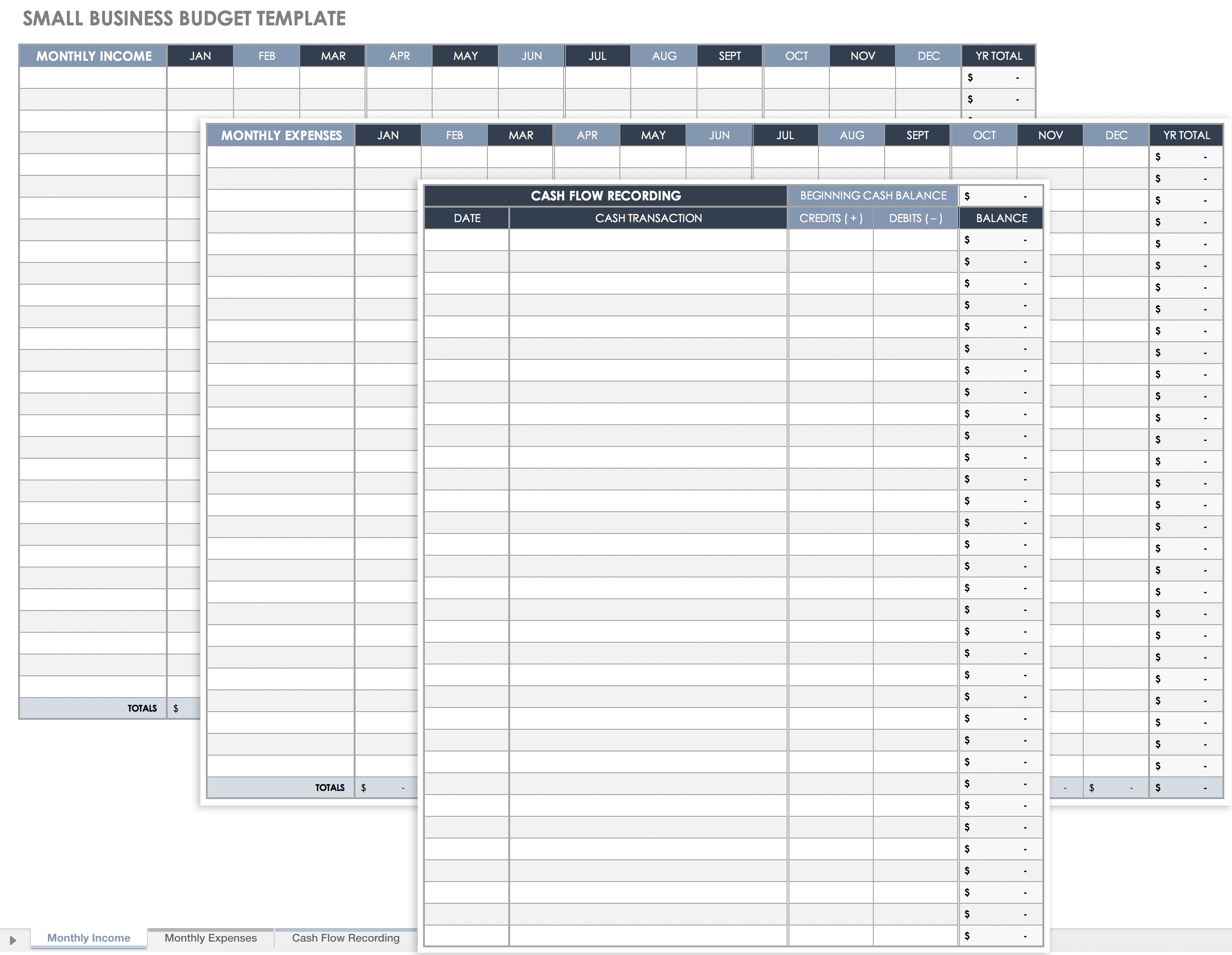
Download Small Business Budget Template Microsoft Excel | Google Sheets | Smartsheet
Use this blank small business template to calculate your income, expenses, and a simplified cash flow. This powerful template adds up your itemized income and expenses each month, giving you a running total while in progress and a yearly total once completed.
Small Business Budget Checklist
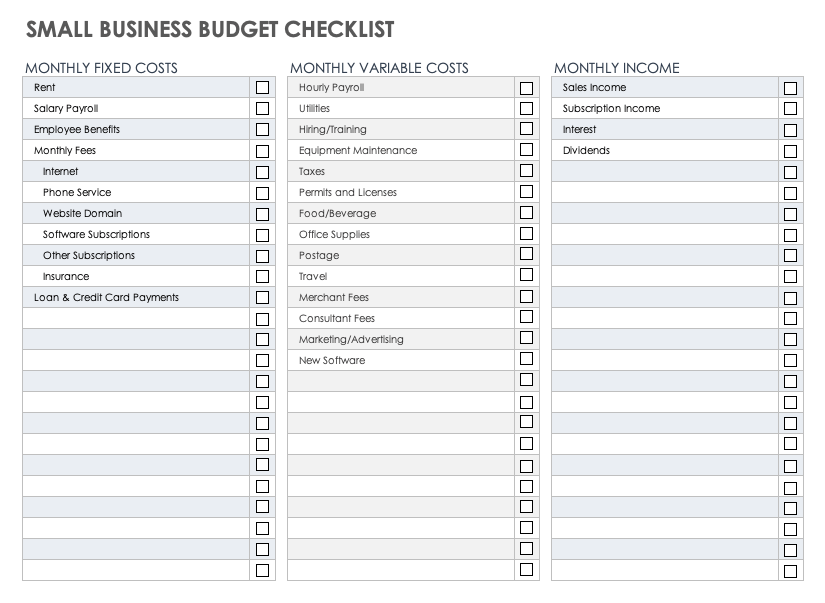
Download Small Business Budget Checklist Microsoft Excel | Adobe PDF | Google Sheets
This customizable small business budget checklist will help ensure that you’ve included all income and expenses in your monthly budget. The checklist includes a list of some of the most common business expenses, but you can edit it as needed.
Small Business Income Statement Template
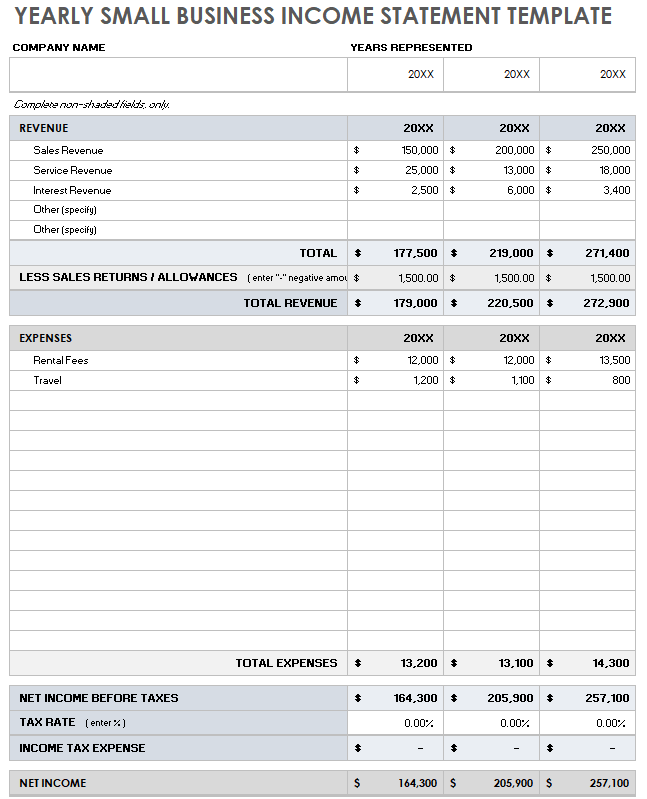
Download Small Business Income Statement Template Microsoft Excel | Google Sheets
Use this small business income statement template to track your company’s total income and expenses over time. Customize it to track by month, quarter, or year, and use it to complete the income and expense information on your budget template.
Small Business Cash Flow Statement Template
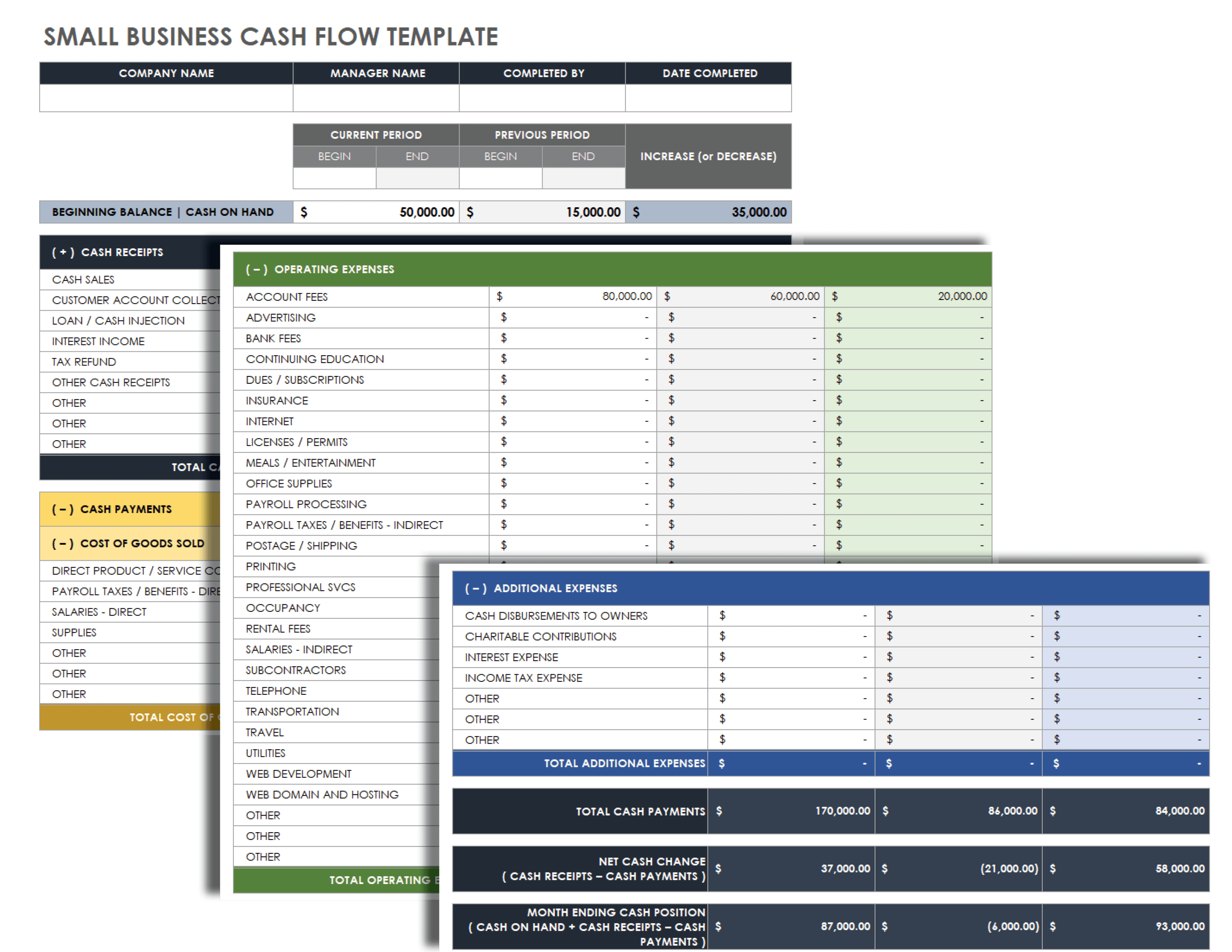
Download Small Business Cash Flow Statement Template Microsoft Excel | Google Sheets
Use this small business cash flow statement template to follow your cash income and expenses. Input your cash flow in the appropriate cell, and compare the current to the previous time period. The template will generate your total cash payments and ending cash position, which will help you fill in your budget template.
Streamline Small Business Budgeting Real-Time Work Management in Smartsheet
Discover a better way to connect your people, processes, and tools with one simple, easy-to-use platform that empowers your team to get more done, faster.
With Smartsheet, you can align your team on strategic initiatives, improve collaboration efforts, and automate repetitive processes, giving you the ability to make better business decisions and boost effectiveness as you scale.
When you wear a lot of hats, you need a tool that empowers you to get more done in less time. Smartsheet helps you achieve that. Try free for 30 days, today .
Connect your people, processes, and tools with one simple, easy-to-use platform.
How to Master the Fine Art of Business Planning and Budgeting
Updated on: 5 January 2023

Starting a business is a challenging thing: you have to work hard and do your best to ensure its success. However, the work doesn’t end even when your business actually becomes operational. You still have to do so much more to ensure that it will keep on track.
Of course, it could be hard, especially for the beginners. It seems that you have to keep an eye on so many things and focus on so many urgent tasks every day that there isn’t any time left for business planning and budgeting. However, it is very important to find that time, because business planning and budgeting are actually one of the most important things for business success.
Why so? Because a plan allows you to get a better understanding of how you see your business, how you want to develop it, and so on. When you create a plan, you set targets that you want to achieve as well as define the ways of evaluating the success of your business.
Basically, planning gives you all the necessary tools that you can use to improve your business in the nearest future. However, this happens only when planning is done correctly.
What to Include in Your Annual Plan?
If you want to create a perfect business plan, you have to know what has to be included in it and how big it will be. Of course, there are no strict limitations to a size of a business plan as each business is different. However, if you are doing it for the first time, I recommend starting with a yearly plan: it is not too big and not too short.
A good annual plan has to include the following things:
- an executive summary
- a list of products and services you offer (or plan to offer this year)
- a detailed description of your target market
- a financial plan
- a marketing plan as well as a sales plan
- milestones and metrics
- a description of your management team
In order to write it in the best way possible, you need to spend some time thinking about the current status of your company as well as how it should look like by the end of the year. Describe your target market, think about the goals that have to be achieved this year, about the products and services that have to be launched.
Visualize the information to make it easier for you to see the whole picture (this is especially important for those, who don’t have much experience in planning). You can use charts, and different diagram types such as mind maps to visualize and organize your ideas and plans.
Try choosing a few main goals for your company and add them to the annual plan being as specific as possible: for example, if you want to increase your earnings, you should specify by how much (10%, 15%, etc.). It’s also good to think about the obstacles you might face and come up with some ways to minimize the potential risks that could occur.
Remember that while a business plan has to be specific and detailed when you write it, it shouldn’t remain static by the end of the year. No business is predictable enough for this to happen: you should understand it and prepare to act quickly, adding changes to a business plan if something unexpected happens.
Business Planning Cycle
As I said, typical business planning isn’t a static thing – actually, it’s a cycle that usually looks like this:
- You take some time to evaluate the effectiveness of your business. In order to do so, you should compare its current performance with the last year’s one – or with targets set earlier this year.
- Then you have to think about opportunities that might appear as well as the threats you might face.
- Remember about both successes and failures your business experienced throughout last year. Analyze them and think what can be done to repeat/avoid them.
- Think of the main business goals you would like to achieve and be sure to add them to the new annual plan (or edit the old one according to them).
- Create a budget.
- Come up with budget targets.
- Complete the plan.
- Be sure to review it regularly (every month, every three months, etc.), making changes if necessary.
Repeat the whole cycle.

Business Planning and Budgeting
When a business is still small and growing, it might seem unnecessary to plan its budget. However, it’s crucial if you want to avoid financial risks and be able to invest in opportunities when they appear.
Moreover, with the rapid growth of your business, you might find yourself in a situation where you aren’t able to control all the money anymore. Expansion of the business usually includes the creation of different departments responsible for different things – and each of these departments needs to have its own budget.
As you see, the bigger your business becomes, the more complicated it gets. While it’s okay to not control every cent by yourself, it is still up to you to make sure that your business keeps growing instead of becoming unprofitable. That’s why it’s so important to create a budget plan that allows you to understand the exact income your business brings by the end of the month and the amount of it, you are able to save or spend on different things.
It is important to remember that a business plan is not a forecast in any way. It doesn’t predict how much money you’ll make by the end of the year. Instead, it’s a tool for ensuring that your business will remain profitable even after covering all the necessary expenses.
Moreover, a business plan also ensures that you’ll have the opportunity to invest money into future projects, fund everything that has to be funded this year, and meet all of the business objectives.
Benefits of a Business Budget
The whole budget planning has a lot of benefits:
It allows you to evaluate the success of your business: when you know exactly how much profit your business gave you at the beginning of the year, you are able to compare it with the profit by the end of the year, understanding whether your financial goals have been met or not.
It allows managing money effectively: for example, if you save money for predicted one-time spends, you won’t be caught by surprise by them.
It helps identify the problems before they actually happen: for example, if you evaluate your budget and see that the income left after covering all the expenses is quite small, you’ll understand that you need to make more profit this year.
It helps make smarter decisions, by only investing money that you can afford to invest.
It allows you to manage your business more effectively, allocating more resources to the projects that need them the most.
It helps in increasing staff motivation.
Basically, when you have a budget plan ready, you have your back covered.
How to Create a Budget?
There are so many articles written on how to create a perfect business budget, but most of them narrow down to these 5 simple things:
- Evaluate your sources of income. You have to find out how much money your business brings on a daily basis in order to understand how much money you can afford to invest and spend.
- Make a list of your fixed expenses. These ones repeat every month and their amount doesn’t change. Some people forget to exclude the sum needed to cover these expenses from the monthly income, but it’s important to do so in order to get a clear understanding of your budget.
- Don’t forget about variable expenses. These ones don’t have a fixed price but still have to be paid every month. Come up with an approximate sum you’ll have to pay and include it in your budget.
- Predict your one-time expenses. Every business needs them from time to time, but if you plan your budget forgetting about these expenses, spending money on them could affect it greatly and not in a positive way.
- When you list all the income and expense sources, it’s time to pull them all together. Evaluate how much money you’ll have each month after you cover all these expenses. Then think of what part of that sum you could afford to invest into something.
While a whole process of budget creation might seem too complicated, you still should find time to do it. It’s totally worth the effort – moreover, such a plan could help you not only throughout the next month but also throughout the next year (if your expense and income sources won’t change much).
Of course, it’s still important to review it from time to time, making changes when necessary. However, the review process won’t be as complicated as the creation of a budget plan from scratch.
Key Steps in Drawing up a Budget
If you’ve never created a budget plan before, you could make some budgeting mistakes . However, when it comes to financial planning, the smallest mistake could have a negative impact. The following tips can help you easily avoid most mistakes, making your budget plan more realistic.
- Try to take it slow
The more time you spend on budgeting, the better it is for you. It’s hard to create a flawless budget plan quickly: there’s a big chance you might miss something. That’s why it’s vital to make sure that you’ve listed all the sources of your income and expenses, and are prepared well.
- You can use last year’s data
Last year’s data could help you see the whole picture better: you can compare it with this year’s data, finding out whether your income has increased or decreased. However, you should use it only for comparing and as a guide. You have new goals and resources this year, and the environment you’re working in has changed too, so your current planning and strategies should differ from the ones you used last year.
- Make sure that a budget is realistic
The most important thing about a budget plan is that it has to cover not only predictable expenses but also less predictable ones. Of course, making predictions is hard but using previous data along with some other business plans as examples could make the whole process easier.
A budget also has to be detailed: the information it contains has to allow you to monitor all the key details of your business, be it sales, costs, and so on. You could also use some accounting software for more effective management.
- It’s okay to involve people
If your business is big enough, you probably have some employees responsible for a part of the financial operations. It’s good to involve them in a budget creation process too, using their knowledge and experience to predict some expenses, for example. If the people you involve are experienced enough, the combination of their professionalism and your knowledge will make a budget more realistic and effective.
- Visualizing helps
Various charts and diagrams are so popular in business for a reason: they allow tracking your incomes and expenses easily. For example, you can create one chart based on your plan and another chart based on an actual budget and compare them during planned revisions to see whether your budget plan works just as expected or not.
As I mentioned above, it’s easier to control finances when you are running a small business. Such business needs only one budget that is created for a certain period – in most cases, for a year. Larger businesses, however, require something else. They have various departments, so it is better to create several budgets at once, tailoring each of them to a certain department’s needs.
Don’t Forget to Review!
I’ve already mentioned that a review is an important process of every business planning and budgeting. No matter how good your plan is, it is impossible to predict everything with 100 percent accuracy. Your business will grow and the environment around it will change, so the quicker you’ll react to such changes, the better it is for you.
That’s why you should schedule budget reviews from time to time. I recommend starting with reviewing it every month and then switching to a more comfortable schedule. Every month review can help you notice the flaws of your plan (which is especially important if you don’t have much experience in this kind of thing) as well as understand how stable your business is.
If you see that you don’t have to make changes often, you could start reviewing your plan every three or six months (however, I recommend doing it more often).
You can use various common diagrams to help you . The best thing about diagrams is that they help visualize data well, which is very important when you need to see the whole picture more clearly – and this happens often during budget planning. For example, a diagram or a chart of your company’s income can show you how much your finances have grown during a certain period. Moreover, if you notice certain downfalls in a chart (that aren’t predicted), you’ll be able to react to it quickly, fixing things that went wrong.
What do you need to consider during the whole review process? First, your actual income. Probably it will be different each month: every business has its own peak sales periods and drop sales ones, and you have to find them and remember them for more effective planning next year. It is important to check whether the income matches the one you predicted or not: if not, you have to find out why it happened.
Second, you have to evaluate your actual expenses. See if they differ from your budget, how much do they affect it, why they exceed your expectations (if they do), and so on.
Probably the best thing about reviewing is that it allows you to react to all the unexpected situations quickly, saving your business from the potential troubles and downfalls. So be sure not to skip it.
As you see, writing a business plan is a complex process. You have to be very attentive, to plan everything, starting with your goals and ending with your expenses, to consider so many things and to involve other people in planning if possible. Moreover, you also have to learn all the time, reviewing your plans, making changes, finding the ways to react to unexpected situations.
But while this might look like a tough thing to do, it is very convenient for everyone who wants to manage their business successfully. The planning takes a lot off your shoulders and makes the whole business running process easier. You are able to evaluate the effectiveness of your business by looking at the monthly income increase, at the goals you wanted to achieve, and so on. You are also able to predict the potential downfalls of your business and to use the tools you have to minimize all the risks.
You are able to evaluate the effectiveness of your business by looking at the monthly income increase, at the goals you wanted to achieve, and so on. You are also able to predict the potential downfalls of your business and to use the tools you have to minimize all the risks.
I hope that this guide will help you create strong and realistic budget and business plans, and successfully implement them in running your business. If you have some tips on business and budget planning that you want to share, please do so in the comment section below!
Author’s Bio:
Kevin Nelson started his career as a research analyst and has changed his sphere of activity to writing services and content marketing. Apart from writing, he spends a lot of time reading psychology and management literature searching for the keystones of motivation ideas. Feel free to connect with him on Facebook , Twitter , Google+ , Linkedin .
Join over thousands of organizations that use Creately to brainstorm, plan, analyze, and execute their projects successfully.

More Related Articles
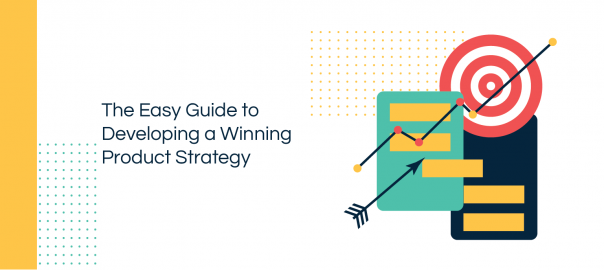
Leave a comment Cancel reply
Please enter an answer in digits: 11 + 2 =
Download our all-new eBook for tips on 50 powerful Business Diagrams for Strategic Planning.
Get expert insights delivered straight to your inbox.
How to Create a Basic Business Budget
8 Min Read | May 16, 2024
You’d never intentionally set your business up to fail, right? But if you don’t know your numbers and how to make a business budget, that’s exactly what you’re doing. Money problems and bad accounting are two reasons why many small businesses don’t make it past their first five years. 1
Talking about budgets can feel overwhelming. We get it. For a lot of business leaders, it’s a lot more comfortable dreaming up big ideas and getting stuff done than digging into numbers. But you can’t set yourself up for steady growth until you have a handle on the money flowing in and out of your company. You also can’t enjoy financial peace in your business.
Not a numbers person? That’s okay. Follow the simple steps below to learn how to create a budget for a business and manage your finances with confidence. We’ll even give you a link to an easy-to-use small-business budget template in the EntreLeader’s Guide to Business Finances .
But before we get to that, let’s unpack what a budget is and why you need one.
Don't Let Your Numbers Intimidate You
With the EntreLeader’s Guide to Business Finances, you can grow your profits without debt—even if numbers aren’t your thing. Plus, get a free business budget template as part of the guide!
What Is a Business Budget?
A business budget is a plan for how you’ll use the money your business generates every month, quarter and year. It’s like looking through a windshield to see the expenses, revenue and profit coming down the road. Your business budget helps you decide what to do with business profit, when and where to cut spending and grow revenue, and how to invest for growth when the time comes. Leadership expert John Maxwell sums it up: “A budget is telling your money where to go instead of wondering where it went.”
But here’s what a business budget is not: a profit and loss (P&L) report you read at the end of the month. Your P&L is like a rearview mirror—it lets you look backward at what’s already happened. Your P&L statement and budget are meant to work together so you can see your financial problems and opportunities and use those findings to forecast your future, set educated goals, and stay on track.
Why Do I Need to Budget for My Business?
Creating a budget should be your very first accounting task because your business won’t survive without it. Sound dramatic? Check this out: There are 33.2 million small businesses in the United States. Out of the small businesses that opened from 1994 to 2020, 67.7% survived at least two years. But less than half survived past five years. 2 The top reasons these businesses went under? They hit a wall with cash-flow problems, faced pricing and cost issues, and failed to plan strategically . 3
As a business owner, one of the worst feelings in the world is wondering whether you’ll be able to make payroll and keep your doors open. That’s why we can’t say it enough: Make a business budget to stay more in control and have more financial peace in running your business.
A budget won’t help you earn more money, but it will help you:
- Maximize the money you’ve got
- Manage your cash flow
- Spend less than your business earns
- Stay on top of tax payments and other bills
- Know if you’re hitting your numbers so you can move at the true speed of cash
How to Create a Budget for a Business
Your ultimate goal is to create a 12–18-month business budget—and you will get there! But start by building out your first month. Don’t even worry about using a fancy accounting program yet. Good ol’ pen and paper or a simple computer document is fine. Just start! Plus, setting up a monthly budget could become a keystone habit that helps kick-start other smart business habits.
Here’s how to create your first budget for business:
1. Write down your revenue streams.
Your revenue is the money you earn in exchange for your products or services. You’ll start your small- business budget by listing all the ways you make money. Look at last month’s P&L—or even just your checking account statement—to help you account for all your revenue streams. You’re not filling in numbers yet. Just list what brings in revenue.
For example, if you run an HVAC business, your revenue streams could be:
- Maintenance service calls
- Repair services and sales
- New unit installation
- Insulation installation
- Air duct cleaning
2. Write down the cost of goods sold (if you have them).
Cost of goods is also called inventory. These expenses are directly related to producing your product or service. In the HVAC example, your cost of goods would be the price you pay for each furnace and air conditioning unit you sell and install. It could also include the cost of thermostats, insulation and new ductwork.
3. List your expense categories.
It’s crazy how much money can slip through the cracks when we’re not careful about putting it in the budget. Think through all your business expenses—down to the last shoe cover your technicians wear to protect your customers’ flooring during house calls. Here’s a list of common business budget categories for expenses to get you started:
- Office supplies and equipment
- Technology services
- Training and education
Related articles : Product Launch: 10 Questions to Ask Before You Launch a New Product New Product Launch: Your 10-Step Checklist
4. Fill in your own numbers.
Now that you have a solid list of revenue and expense categories, plug in your real (or projected) numbers associated with them. It’s okay if you’re not sure how much you’ll sell just yet or exactly how much you’ll spend. Make an educated guess if you’re just starting out. If your business has been earning money for a while, use past P&L statements to guide what you expect to bring in. Your first budget is about combining thoughtful guesswork with history and then getting a more realistic picture month over month.
5. Calculate your expected profit (or loss).
Now, number nerds and number haters alike—buckle in. We’re about to do some basic accounting so you know whether you have a profit or loss. This is your chance to figure out exactly how much you’re spending and making in your business.
Take your gross revenue (the total amount of money you expect to make this month) and subtract your expenses and cost of goods sold to find your profit or loss. Here’s what that calculation looks like:
Revenue - Expenses - Cost of Goods Sold = Profit or Loss
Don’t freak out if your first budget shows a loss. That actually happens a lot with your first few monthly budgets. You’re learning and getting context on what’s coming in and going out so you can make adjustments. Keep doing your budget, and before you know it, you’ll be a rock star at telling your money where to go, planning for emergencies , investments and opportunities , and building momentum.
6. Review your budget often.
Whew! Once you get that first business budget under your belt, take a deep breath and celebrate. You’ve just done something huge for your business! (You’ll also be happy to know, budgeting gets easier from here since you can copy and paste your first one and tweak your income and expenses each month.)
But here’s the thing: Your budget can’t just sit in a drawer or on your computer. You’ve got to look at it consistently to make sure you’re actually following it.
Weekly Review
At least once a week, someone in your business (whether it’s you, a qualified team member or a bookkeeper) needs to track your transactions so you know what’s happening with your money all month. Then you can make adjustments before you have more month than money.
Every time you review your budget, ask yourself these three questions:
- Are we on target to hit our revenue goal this month?
- If not, what we can change to get there?
- Are there any expenses we can cut or minimize?
Monthly Review
You also need to review your business budget when you close your books every month to compare it to your actuals—your P&L. Otherwise, how can you know how you’re doing?
7. Work toward a 12–18-month budget.
Now that you’ve created your first month’s budget, move on to the next one. You’ve got this! The more budget-building reps you get in, the better you’ll be at looking forward and planning for growth. In no time, you’ll reach that ultimate goal of a 12–18-month budget. Just keep adjusting as you go based on all you’re learning about getting an accurate road map for your finances.
As you start owning your numbers, remember: It’s okay if you’re a little intimidated by the process of accounting and making a budget for business. But it’s not okay to avoid the financial details that will make or break you. So just keep applying the basics we covered and keep moving forward.
Follow the steps above to create your budget, and review it often to stay on track.
Want a tool to make budget building simpler? Check out the EntreLeader’s Guide to Business Finances. It includes an easy-to-use small-business budget template in the extra resources section.
What are the benefits of budgeting?
A business budget will help you:
- Make informed, strategic decisions
- Invest in under-resourced areas
- Trim over-resourced areas
- Plan for the future
- Set goals and track your progress
Does using a small-business budget template save time?
Yes! Using a small-business budget template helps you plug in the numbers you need to operate with more confidence and fewer wrong turns. Check out the small-business-budget template inside our EntreLeader’s Guide to Business Finances .
How do I budget if I own a seasonal business?
Just like farmers put extra hay in the barn to cover leaner months, if you’re a seasonal business owner, you need to set aside resources in times of plenty to cover months your business turns down. Use your P&L statements to go back in time and look at financial performance year over year. Then, create your business budget based on what you learn and on any changes you see coming. You can also go to trade conferences to get an idea of your industry’s seasonal benchmarks.
Did you find this article helpful? Share it!
About the author
EntreLeadership
EntreLeadership is the part of Ramsey Solutions that exists to help small-business owners thrive by mastering themselves, rallying their teams, and imposing their will on the marketplace. Thousands of leaders use our proven EntreLeadership System and resources to develop as leaders and grow their businesses. These resources include The EntreLeadership Podcast , EntreLeadership Elite digital membership , books, live events, coaching sessions and business workshops. Learn More.
7 Tips for How to Run a Business Debt-Free
True or false: Running a business requires debt. The answer? False. The truth is, you can’t run a business if you’re broke—and debt increases your risk of going broke when a storm hits. Here’s how to run a business debt-free.
How to Create a Profit-Sharing Plan
It's easy to feel discouraged when trying to compete for top talent and keep your team happy. Learn how a profit-sharing plan can help you build and keep an awesome team even when the market shifts.
How to create a business budget
Advertiser disclosure.
We are an independent, advertising-supported comparison service. Our goal is to help you make smarter financial decisions by providing you with interactive tools and financial calculators, publishing original and objective content, by enabling you to conduct research and compare information for free - so that you can make financial decisions with confidence.
Bankrate has partnerships with issuers including, but not limited to, American Express, Bank of America, Capital One, Chase, Citi and Discover.
How We Make Money
The offers that appear on this site are from companies that compensate us. This compensation may impact how and where products appear on this site, including, for example, the order in which they may appear within the listing categories, except where prohibited by law for our mortgage, home equity and other home lending products. But this compensation does not influence the information we publish, or the reviews that you see on this site. We do not include the universe of companies or financial offers that may be available to you.
- Share this article on Facebook Facebook
- Share this article on Twitter Twitter
- Share this article on LinkedIn Linkedin
- Share this article via email Email

- • Small business loans
- • Bad credit loans

- • Funding inequality
- Connect with Emily Maracle on LinkedIn Linkedin
- Get in contact with Emily Maracle via Email Email
The Bankrate promise
At Bankrate we strive to help you make smarter financial decisions. While we adhere to strict editorial integrity , this post may contain references to products from our partners. Here's an explanation for how we make money .
Founded in 1976, Bankrate has a long track record of helping people make smart financial choices. We’ve maintained this reputation for over four decades by demystifying the financial decision-making process and giving people confidence in which actions to take next.
Bankrate follows a strict editorial policy , so you can trust that we’re putting your interests first. All of our content is authored by highly qualified professionals and edited by subject matter experts , who ensure everything we publish is objective, accurate and trustworthy.
Our banking reporters and editors focus on the points consumers care about most — the best banks, latest rates, different types of accounts, money-saving tips and more — so you can feel confident as you’re managing your money.
Editorial integrity
Bankrate follows a strict editorial policy , so you can trust that we’re putting your interests first. Our award-winning editors and reporters create honest and accurate content to help you make the right financial decisions.
Key Principles
We value your trust. Our mission is to provide readers with accurate and unbiased information, and we have editorial standards in place to ensure that happens. Our editors and reporters thoroughly fact-check editorial content to ensure the information you’re reading is accurate. We maintain a firewall between our advertisers and our editorial team. Our editorial team does not receive direct compensation from our advertisers.
Editorial Independence
Bankrate’s editorial team writes on behalf of YOU – the reader. Our goal is to give you the best advice to help you make smart personal finance decisions. We follow strict guidelines to ensure that our editorial content is not influenced by advertisers. Our editorial team receives no direct compensation from advertisers, and our content is thoroughly fact-checked to ensure accuracy. So, whether you’re reading an article or a review, you can trust that you’re getting credible and dependable information.
How we make money
You have money questions. Bankrate has answers. Our experts have been helping you master your money for over four decades. We continually strive to provide consumers with the expert advice and tools needed to succeed throughout life’s financial journey.
Bankrate follows a strict editorial policy , so you can trust that our content is honest and accurate. Our award-winning editors and reporters create honest and accurate content to help you make the right financial decisions. The content created by our editorial staff is objective, factual, and not influenced by our advertisers.
We’re transparent about how we are able to bring quality content, competitive rates, and useful tools to you by explaining how we make money.
Bankrate.com is an independent, advertising-supported publisher and comparison service. We are compensated in exchange for placement of sponsored products and services, or by you clicking on certain links posted on our site. Therefore, this compensation may impact how, where and in what order products appear within listing categories, except where prohibited by law for our mortgage, home equity and other home lending products. Other factors, such as our own proprietary website rules and whether a product is offered in your area or at your self-selected credit score range, can also impact how and where products appear on this site. While we strive to provide a wide range of offers, Bankrate does not include information about every financial or credit product or service.
Our writers and editors used an in-house natural language generation platform to assist with portions of this article, allowing them to focus on adding information that is uniquely helpful. The article was reviewed, fact-checked and edited by our editorial staff prior to publication.
Key takeaways
- A business budget is a financial plan that helps estimate a company's revenue and expenses, making it an essential tool for small businesses
- The steps to creating a business budget include choosing budget and accounting software, listing expenses and forecasting revenue
- If a business finds itself in a budget deficit, strategies such as cutting costs, negotiating with suppliers and diversifying revenue streams can help
As a small business owner, keeping your finances organized through a business budget is crucial to running a successful company.
Business budgeting involves creating a financial plan that estimates future revenue and expenses to make informed financial decisions, which can ultimately move the needle on your business’s financial goals and help it grow in profitability.
What is a business budget?
A business budget is a financial plan that outlines the company’s current revenue and expenses. The budget also forecasts expected revenue that can be used for future business activities, such as purchasing equipment. It sets targets for your business’s revenue, expenses and profit and helps you determine if you’ll have more money coming in than you pay out.
A business budget is an essential tool that helps you make wise business decisions. Without it, it’s difficult to gauge your business’s financial health.
What is the difference between a cash flow statement and a business budget?
A cash flow statement (CFS) is a financial document that summarizes the movement of cash coming in and going out of a company. The CFS gauges how effectively a company manages its finances, including how it manages debt responsibilities and funds day-to-day operations.
It’s similar to a business budget in that you can see expenses and revenue. But while a budget gives a moment-in-time snapshot of your business’s financial performance compared to forecasts, the cash flow statement focuses on the actual inflows and outflows of money through your business.
Follow these steps to ensure a well-developed budget, from understanding your expenses to generating revenue and adjusting expenses to balance the budget.
1. Choose a budget and accounting software
First, you’ll want to store your expense and revenue information with accounting software to help you track your numbers and generate reports. Some software may also help you assign categories to the transactions, identify tax deductions and file taxes. Quickbooks is an example of accounting software.
Some business bank accounts also have accounting software built in, helping you stay organized by keeping your accounting and banking in one place.
2. List your business expenses
The next step in creating a small business budget is to list all your business expenses. Here are the types of expenses you want to include in your budget:
- Fixed expenses: Fixed expenses cost a fixed amount monthly or within the assessed period. Those costs include rent, insurance, salaries and loan payments.
- Variable expenses: Variable expenses can change monthly or over time, making them trickier to budget. This might include materials, direct labor, utility bills or marketing expenses.
- Annual or one-time costs: Some costs only occur a few times per year, while others you’ll only pay for as needed, such as buying new equipment. You still want to budget for these expenses by allocating a portion of your weekly or monthly budget toward one-time expenses.
- Contingency funds: Unexpected business costs can throw a wrench in your budget if not planned for. Such costs could include emergency repairs, necessary equipment purchases, sudden tax increases or unforeseen legal fees. To plan for these costs, you can create a contingency or emergency fund that’s separate from your operational budget.
- Maintenance costs: To allocate funds for maintenance costs, begin by including regular inspections and maintenance in your budget. Then, make sure to leave room for changes and unexpected maintenance costs.
3. Forecast your revenue
To estimate your future revenue, start by deciding on a timeline for your forecast. A good place to start is the previous 12 months. Your accounting software may also include revenue forecasting as one of its features, which can automate this step for you.
The timeline and your recent past growth can help you understand how much revenue you’ll generate in the future. Consider external factors that could drive revenue growth, such as planned business activities like expansion, marketing campaigns or new product launches.
You’ll also want to think about anything that might slow your growth. Many businesses experience seasonal fluctuations, which can impact your budget if you don’t plan for it. To account for these changes, list the minimum expenses required to keep your business running. Use your financial statements to understand these costs, and consider averaging out irregular expenses over the year to avoid surprises.
Ideally, your business should build a cash reserve during profitable periods to cover expenses during slower seasons. If necessary, consider various financing options, such as a business credit card or line of credit, that you can draw from to manage cash flow during peak or off times.
4. Calculate your profits
The next step in creating a business budget is to calculate your business profits. You can look at your total profits by calculating revenue minus expenses. That way, you see how much money you have to work with, called your working capital .
You should also understand your profit margins for each of your products and services, which can help you set prices or decide whether to offer a new product or service.
How to calculate your profit margins
To find out your gross profit margin, you’ll first need to calculate the gross profit. To calculate your business’s gross profit, subtract the cost of goods sold (COGS) from your total revenue. COGS includes all the expenses related to producing your products and services.
Once you have the gross profit, use the gross profit margin formula: (Revenue – COGS) / Revenue x 100. This will give you a percentage that shows how much profit you gain from that particular product after accounting for the product’s costs.
5. Make a strategy for your working capital
Knowing what to do with extra revenue, which is your working capital, is crucial for managing your business finances and growth. Here’s how to get started with a financial strategy that propels your business goals forward:
- Set spending limits for different categories in your budget. When listing your expenses, you should have set a dollar amount for each category. You can estimate this by a monthly average or a general forecasted amount.
- Set realistic short- and long-term goals. These goals will motivate you to stick to your budget and guide your spending decisions.
- Compare your actual spending with your net income and priorities. Look at the areas you’re spending and consider whether you need to reallocate money to different categories. Consider separating expenses into business needs and extras.
- Adjust your budget and actual spending. Adjust your spending to ensure you do not overspend and can allocate money towards your goals. If you need to cut spending, consider the categories that are extras, such as types of marketing that you don’t know will generate a return on investment.
6. Review your budget and forecasts regularly
Finally, review your budget regularly. By frequently checking in on your budget, you can identify any discrepancies between your planned and actual expenses and adjust accordingly. This allows you to proactively handle any financial issues that may arise rather than reacting to them after they’ve become a problem.
Regular reviews also allow you to refine your budgeting process and improve its accuracy over time. Keep in mind that your budget is not set in stone but rather a tool to guide your financial decisions and help you achieve your business goals.
What to do if you have a deficit in your business budget
Finding a deficit in your small business budget can be alarming, but there are several strategies you can employ to handle this situation.
- Do a cash flow analysis. Begin by doing a cash flow analysis to review what your business is earning and spending money on. Identify potential problems and adjust the budget as needed to prevent overspending.
- Cut nonessential business costs. Cutting spending may involve eliminating nonessential costs and transferring funds from other categories to overspent categories. Your goal is a balanced or profitable budget.
- Negotiate with suppliers. Be transparent in your communications with suppliers and explain your quality standards and why you’re seeking cost reduction. Explore options for cost reduction that do not compromise quality, such as process improvements or ordering in larger quantities.
- Create a lean business model. By removing anything that doesn’t benefit your customer, your business can potentially save time and resources. Lean business models focus on continually improving processes and customer experience without adding additional resources, time or funds.
- Add revenue and diversify revenue streams. Raising revenue requires a realistic plan with measurable goals to increase sales and overall business income. You can also consider other products and services you could offer that would make your business profitable.
- Use financing to cover temporary gaps. Applying for a small business loan can help pay bills during an unplanned shortfall. Since this will add an expense to your budget, make sure you can handle the loan repayments and your regular expenses.
- Plan for a deficit. In some cases, a planned budget deficit might be a strategic decision, such as investing in new opportunities that promise long-term benefits.
Bottom line
Having a well-developed business budget is crucial for making informed decisions. You can effectively manage your small business’s finances by tracking and analyzing your business’s inflows and outflows, forecasting your expected revenue and adjusting your budget to stay balanced.
Even in the face of a budget deficit, there are various strategies you can use to keep your business profitable, including negotiating costs with your suppliers, assessing your business operations and offering new products and services.
With a solid business budget in place, you can confidently navigate financial challenges and drive long-term success for your small business.
Frequently asked questions
What are the benefits of a business budget, what are the components of a business budget, how do you calculate fixed and variable costs in a business budget.

Related Articles

How to make a monthly budget in 5 simple steps

How to bootstrap your small business

How to finance a small business for the holidays

How to start a small business
This device is too small
If you're on a Galaxy Fold, consider unfolding your phone or viewing it in full screen to best optimize your experience.
- Small Business
- The Top 10 Accounting Software for Small Businesses
How to Create a Business Budget for Your Small Business
See Full Bio
Our Small Business Expert
If you’ve just started your business, chances are that you have yet to create a budget. But it’s difficult to grow your business, meet any short- or long-term goals, or obtain outside investors or financing without accurate financial projections, which requires a small business budget.
Creating a budget also plays an important role in the the accounting cycle, which ensures that all financial transactions are properly accounted for.
And while the act of creating a budget may seem daunting, it’s much like creating a personal budget. You identify what you own of value (your assets), estimate your upcoming expenses, and account for and grow your revenue base.
If you know how to create an expense report or how to write an invoice, and are comfortable with the basics of bookkeeping, you can certainly handle business budget planning.
By creating, and more importantly, following a budget, you can eliminate wasteful spending, develop plans to expand your revenue base, and work toward your set goals in a productive fashion.
5 types of budgets for businesses
Budgets help businesses track and manage their resources. Businesses use a variety of budgets to measure their spending and develop effective strategies for maximizing their assets and revenues. The following types of budgets are commonly used by businesses:
1. Master budget
A master budget is an aggregate of a company's individual budgets designed to present a complete picture of its financial activity and health. The master budget combines factors like sales, operating expenses, assets, and income streams to allow companies to establish goals and evaluate their overall performance, as well as that of individual cost centers within the organization.
Master budgets are often used in larger companies to keep all individual managers aligned.
2. Operating budget
An operating budget is a forecast and analysis of projected income and expenses over the course of a specified time period.
To create an accurate picture, operating budgets must account for factors such as sales, production, labor costs, materials costs, overhead, manufacturing costs, and administrative expenses. Operating budgets are generally created on a weekly, monthly, or yearly basis. A manager might compare these reports month after month to see if a company is overspending on supplies.
3. Cash flow budget
A cash flow budget is a means of projecting how and when cash comes in and flows out of a business within a specified time period. It can be useful in helping a company determine whether it's managing its cash wisely.
Cash flow budgets consider factors such as accounts payable and accounts receivable to assess whether a company has ample cash on hand to continue operating, the extent to which it is using its cash productively, and its likelihood of generating cash in the near future.
A construction company, for example, might use its cash flow budget to determine whether it can start a new building project before getting paid for the work it has in progress.
4. Financial budget
A financial budget presents a company's strategy for managing its assets, cash flow, income, and expenses. A financial budget is used to establish a picture of a company's financial health and present a comprehensive overview of its spending relative to revenues from core operations.
A software company, for instance, might use its financial budget to determine its value in the context of a public stock offering or merger.
5. Static budget
A static budget, unlike a flexible budget, is a fixed budget that remains unaltered regardless of changes in factors such as sales volume or revenue. A plumbing supply company, for example, might have a static budget in place each year for warehousing and storage, regardless of how much inventory it moves in and out due to increased or decreased sales.
How to make a budget for your small business
One of the easiest and most accurate ways to create a budget is to review your revenue and costs for the past year and use those numbers when creating your new budget.
If your business is brand new, you’ll have to be a bit more creative, relying on obtaining numbers from the last few months, or researching similar businesses to obtain accurate estimates on revenue and expenses.
However you do it, learning budgeting for business is a lot easier than you imagine.
Step 1: Review your revenue
The first step toward creating a budget is to examine your revenue: not just the total for any given time, but specifics, such as months when revenue rose or dipped. This is particularly important for managing cash flow.
For instance, many retailers earn a large part of their yearly revenue in the months of November and December, while January and February typically are very slow in sales.
Knowing this information and including it in your budget can help you be better prepared for both the busy and the slow months.
Step 2: Take a look at your fixed expenses
As a small business owner, you should know what your regular monthly expenses are. If you know how to track business expenses such as rent, insurance, salaries, and utilities, you can create a budget.
Factoring these items into your budget helps to ensure that you’re accounting for these expenses properly.
Step 3: Factor in variable expenses
Whether in our personal lives or in business, we need to factor in variable expenses.
For instance, you may need to hire a temp if your office manager becomes unexpectedly ill. Other variable costs can include advertising and marketing, as well as postage or printing costs. Travel is another cost that may be planned (you know you’re going to a convention in May), but the final cost is not yet known.
Factoring in variable expenses can help with your bottom line. Don’t be conservative in estimating these costs, You’d rather they be too high, leaving you more money than expected for the month than the opposite.
Step 4: Include one-time and unexpected costs
While it may seem counterintuitive to include unexpected costs into your budget when they haven’t even occurred yet, you can safely assume that something unexpected will happen.
Your computer crashes and needs to be repaired, or worse, replaced. Or maybe your company car dies. These are both examples of unexpected costs. You can also plan for one-time costs.
For instance, you know you’ll be upgrading employee laptops in December. This allows you to plan for this expense in advance, ensuring that the funds should be available.
Step 5: Put all your information into a budget format
The ideal situation is to prepare your budget details in your accounting software application.
However, not all accounting software, particularly those designed for small businesses, include a budgeting feature. In that case, you can use Microsoft Excel or similar spreadsheet software to prepare your budget.
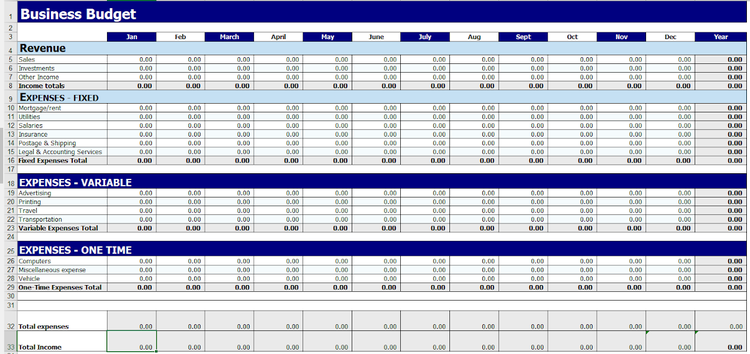
This Microsoft Excel spreadsheet can be used to create your business budget. Image source: Author
One of the main advantages of preparing a budget in your accounting software application is that you can track budget versus actual revenue and expenses. This lets you see how accurate (or not) your budget is, allowing you to perhaps make some mid-year adjustments.
Things to consider when making a budget for your business
Creating a budget is a great first step toward managing your business properly. However, it’s important when creating your budget that you do your best to make it as accurate as possible. There are numerous ways to do that, including the following:
1. Be conservative with revenue
When entering revenue totals, be conservative. At the beginning of the year, we're all optimistic. But be sure when you budget your revenue, you enter numbers that are as accurate as possible.
When planning for revenue growth, be conservative as well, perhaps budgeting for a 5%-10% growth for the year. If you exceed that level, great. You’ll have money to spare. But if you don’t, you’ll end up with a loss, which is not where you want your business to be.
2. Plan for growth
Planning for growth is important when calculating budget revenue, but you’ll have to account for added expenses as well.
Yes, if your business grows, your revenue will increase, but so will your overhead, as you increase advertising, add employees, and pay additional taxes. So when planning for business growth, be sure to factor in your increased expenses as well.
3. Unexpected expenses
This is an important one. One catastrophe can be disastrous for your business, particularly if you operate on limited cash flow.
When budgeting, just assume that your business will have at least one major unexpected expense during the year. If it doesn’t, great. You can bank that money for when the unexpected does occur.
4. Long-term goals
Before completing your budget, you might want to consider your long-term goals.
Do you plan on increasing your customer base each year by 5%? Perhaps you’re working out of your home, but plan on renting or buying a building for your business in the next year or two.
Be sure to factor that into your budget, and plan your income and expenses accordingly.
The best accounting software for tracking your small business budget
Not every accounting software application offers budgeting capability, but the following small business accounting software applications do.
If you’re looking to make the move to accounting software, or are looking for an application that allows you to create and manage a budget for your business, be sure and check out these applications.
Xero lets you easily create a budget using their Budget Manager feature. You can choose your start date for any budget, and prepare a budget of 3, 6, 12, or 24 months. Xero also allows you to compare any created budget to actual totals, to see how far under or over budget your company is.

The Budget Manager lets you choose start date, actuals, and period of time for each budget. Image source: Author
You can copy budget details from actuals for the prior year, copy data from an existing budget, or create a new budget from scratch. Adjustments can be made for each budget period, so you can adjust the amount each month to increase budgeted totals by a set amount or by percentage. This is a great way to budget for growth.
2. QuickBooks Online
The budgeting feature in QuickBooks Online lets you create a yearly budget easily. Just choose the correct fiscal year, click on the “Add Budget” button, and start entering budget details.
You can choose to pre-fill budget data using actual QuickBooks Online data or just create a budget from scratch. You have the option to create a monthly, quarterly, or yearly budget, and can choose to subdivide your budget by customer, class, or location, or just enter a single total into the appropriate fields.
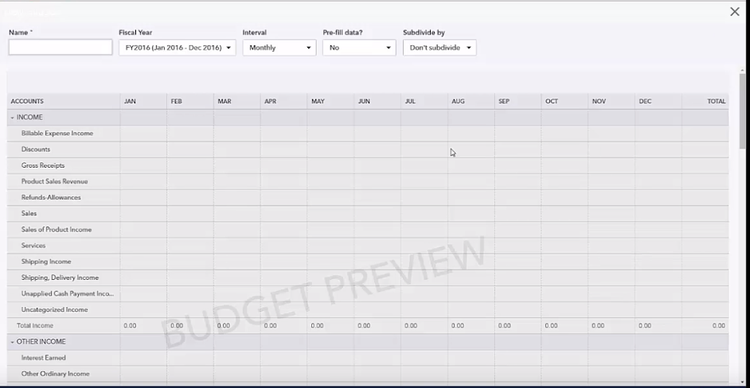
The Budget Preview feature lets you preview your newly created budget for accuracy. Image source: Author
Budget data can be edited when desired, and to get a sense of your business performance, run the Budget vs. Actuals report, which displays current company performance to date.
3. Zoho Books
Zoho Books offers excellent budget creation capability, offering three ways to enter budget data:
- Auto-fill budget information based on current income and expense accounts
- Pre-fill from last year’s actual numbers
- Start from scratch, entering budget numbers manually
Like Xero, Zoho Books lets you enter budget numbers for a single period, then specify a percentage increase or decrease in budgeted numbers.
For instance, if your short-term plan for this year is to increase your revenue by 5% each quarter, you can enter that information in Zoho Books, and it will automatically calculate the 5% increase and auto-fill the rest of the budget. You can also apply a fixed amount for each period.
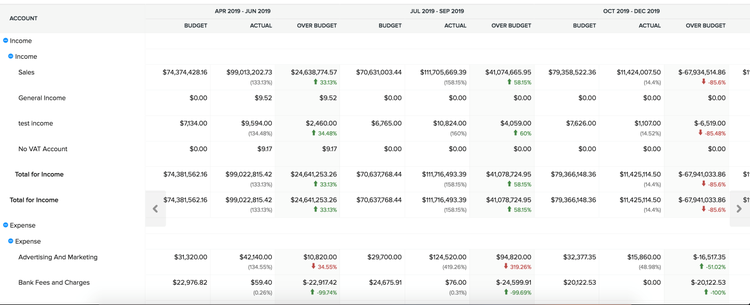
Zoho Books offers a comprehensive budget management feature with multiple entry options. Image source: Author
At the end of the specified budget period, you can compare actuals against your budgeted amounts to view business performance and make any adjustments going forward.
Get started on your budget today
Now that you know how easy it is to prepare a budget for your small business, what are you waiting for?
Completing a budget for your business will provide you with the information you need to grow your business, plan for the unexpected, and stay on track for the future.
We're firm believers in the Golden Rule, which is why editorial opinions are ours alone and have not been previously reviewed, approved, or endorsed by included advertisers. The Ascent, a Motley Fool service, does not cover all offers on the market. The Ascent has a dedicated team of editors and analysts focused on personal finance, and they follow the same set of publishing standards and editorial integrity while maintaining professional separation from the analysts and editors on other Motley Fool brands.
The Ascent is a Motley Fool service that rates and reviews essential products for your everyday money matters.
Copyright © 2018 - 2024 The Ascent. All rights reserved.
- Business Essentials
- Leadership & Management
- Credential of Leadership, Impact, and Management in Business (CLIMB)
- Entrepreneurship & Innovation
- Digital Transformation
- Finance & Accounting
- Business in Society
- For Organizations
- Support Portal
- Media Coverage
- Founding Donors
- Leadership Team

- Harvard Business School →
- HBS Online →
- Business Insights →
Business Insights
Harvard Business School Online's Business Insights Blog provides the career insights you need to achieve your goals and gain confidence in your business skills.
- Career Development
- Communication
- Decision-Making
- Earning Your MBA
- Negotiation
- News & Events
- Productivity
- Staff Spotlight
- Student Profiles
- Work-Life Balance
- AI Essentials for Business
- Alternative Investments
- Business Analytics
- Business Strategy
- Business and Climate Change
- Design Thinking and Innovation
- Digital Marketing Strategy
- Disruptive Strategy
- Economics for Managers
- Entrepreneurship Essentials
- Financial Accounting
- Global Business
- Launching Tech Ventures
- Leadership Principles
- Leadership, Ethics, and Corporate Accountability
- Leading Change and Organizational Renewal
- Leading with Finance
- Management Essentials
- Negotiation Mastery
- Organizational Leadership
- Power and Influence for Positive Impact
- Strategy Execution
- Sustainable Business Strategy
- Sustainable Investing
- Winning with Digital Platforms
How to Prepare a Budget for an Organization: 4 Steps

- 16 Nov 2021
An organization’s budget dictates how it leverages capital to work toward goals. For this reason, the ability to prepare a budget is one of the most crucial skills for any business leader —whether a current or aspiring entrepreneur, executive, functional lead, or manager.
Before preparing your first organizational budget, it’s important to understand what goes into a budget and the key steps involved in creating one.
What Is a Budget?
A budget is a document businesses use to track income and expenses in a detailed enough way to make operational decisions.
Budgets are typically forward-looking in nature. Income is based on projections and estimates for the periods they cover, as are expenses. For this reason, organizations often create both short- (monthly or quarterly) and long-term (annual) budgets, where the short-term budget is regularly adjusted to ensure the long-term budget stays on track.
Access your free e-book today.
Most organizations also prepare what’s known as an “actual budget” or “actual report” to compare estimates against reality following the period covered by the budget. This allows an organization to understand where it went wrong in the budgeting process and adjust estimates moving forward.
Budget vs. Cash Flow Statement
If the definition above sounds similar to a cash flow statement , you’re right: Your organization’s budget and cash flow statement are similar in that they both monitor the flow of money into and out of your business. Yet, they differ in key ways.
First, a budget typically offers more granular details about how money is spent than a cash flow statement does. This provides greater context for making tactical business decisions, such as considering where to trim business expenses.
Related: The Beginner’s Guide to Reading & Understanding Financial Statements
Second, a budget is, quite literally, a tool used to direct work done within an organization. The cash flow statement plays a different role by offering a higher-level overview of how money moves into, throughout, and out of an organization.
Instead of thinking of the two documents as competing, view them as complementary, with each playing a role in driving your business’s performance.
Steps to Prepare a Budget for Your Organization
The steps below can be followed whether creating a budget for a project, initiative, department, or entire organization.
1. Understand Your Organization’s Goals
Before you compile your budget, it’s important to have a firm understanding of the goals your organization is working toward in the period covered by it. By understanding those goals, you can prepare a budget that aligns with and facilitates them.
Related: The Advantages of Data-Driven Decision-Making
For example, consider a business that regularly experiences year-over-year revenue growth that’s offset by rising expenses. That organization might benefit from focusing efforts on better controlling expenses during the budgeting process.
Alternatively, consider a company launching a new product or service. The company may invest more heavily in the fledgling business line to grow it. With this goal, the company may need to trim expenses or growth initiatives elsewhere in its budget.
2. Estimate Your Income for the Period Covered by the Budget
To allocate funds for business expenses, you first need to determine your income and cash flow for the period to the best of your ability.
Depending on the nature of your organization, this can be a simple or complicated process. For example, a business that sells products or services to known clients locked in with contracts will likely have an easier time estimating income than a business that depends on active sales activity. In the second case, it would be important to reference historical sales and marketing data to understand whether the market is changing in a way that might cause you to miss or exceed historical trends.
Related: How to Read & Understand an Income Statement
Beyond income from sales activity, you should include other income sources, such as returns on investments, asset sales, and bond or share offerings.

3. Identify Your Expenses
Once you understand your projected income for the period, you need to estimate your expenses. This process involves three main categories: fixed costs, variable expenses, and one-time expenses.
Fixed costs are any expenses that remain constant over time and don’t dramatically vary from week to week or month to month. In many cases, those expenses are locked in by some form of contract, making it easy to anticipate and account for them. This category usually includes expenses related to overhead, such as rent payments and utilities. Phone, data, and software subscriptions can also fall into this category, along with debt payments. Any expense that’s regular and expected should be included.
Related: 6 Budgeting Tips for Managers
Variable expenses are those your business incurs, which vary over time depending on several factors, including sales activities. Your shipping and distribution costs, for example, are likely to be higher during a period when you sell more product than one when you sell less product. Likewise, utilities such as water, gas, and electricity will be higher during periods of increased use. This is especially true for businesses that manufacture their own products. Sales commissions, materials costs, and labor costs are other examples of variable expenses.
Both fixed expenses and variable expenses are recurring in nature, making it easy to account for them (even if variable expenses must be projected). One-time expenses , also called “one-time spends,” don’t recur and happen more rarely. Purchasing equipment or facilities, developing a new product or service, hiring a consultant, and handling a security breach are all examples of one-time expenses. Understanding major initiatives—and what it will take to accomplish them—and what you’ve spent in previous years on similar expenses can help account for them in your budget, even if you’re unsure of their exact values.
4. Determine Your Budget Surplus or Deficit
After you’ve accounted for all your income and expenses, you can apply them to your budget. This is where you determine whether you have enough projected income to cover all your expenses.
If you have more than enough income to cover your expenses, you have a budget surplus. Knowing this, you should determine how to use additional funds best. You may, for example, move the money into a rainy day fund you can access should your actual income fall short of projections. Alternatively, you may deploy the funds to grow your business.
On the other hand, if your expenses exceed your income, you have a budget deficit. At this point, you must identify the best path forward to close the gap. Can you bring in additional funds by selling more aggressively? Can you lower your fixed or variable expenses? Would you consider selling bonds or shares of company stock to infuse the business with additional capital?

An Important Financial Statement
The person responsible for generating a budget varies depending on an organization’s nature and its budgetary goals. An entrepreneur or small business owner, for example, is likely to prepare an organizational budget on their own. Meanwhile, a larger organization may rely on a member of the accounting department to generate a budget for the entire business. Individual department heads or functional leads might also be called on to submit budget proposals for their teams.
With this in mind, anyone who aspires to start their own business or move into an organizational leadership position can benefit from learning how to prepare a budget.
Do you want to take your career to the next level? Consider enrolling in our eight-week Financial Accounting course or three-course Credential of Readiness (CORe) program to learn financial concepts that can enable you to unlock critical insights into business performance and potential. Not sure which course is right for you? Download our free flowchart .

About the Author
The Best Free Business Budget Templates
Published: October 12, 2023
Business budgets are a source of truth for your income and expenses. That includes all the money you spend — from A/B testing your marketing campaigns to your monthly office rent.

While organizing the numbers may sound difficult, using a business budget template makes the process simple. Plus, there are thousands of business budget templates for you to choose from.

We’ll share seven budget templates that can help organize your finances. But first, you’ll learn about different types of business budgets and how to create one.
What is a Business Budget?
A business budget is a spending plan that estimates the revenue and expenses of a business for a period of time, typically monthly, quarterly, or yearly.
The business budget follows a set template, which you can fill in with estimated revenues, plus any recurring or expected business expenses.
For example, say your business is planning a website redesign. You'd need to break down the costs by category: software, content and design, testing, and more.
Having a clear breakdown will help you estimate how much each category will cost and compare it with the actual costs.

Image Source

Types of Budgets for a Business
Master budget, operating budget, cash budget, static budget, departmental budget, capital budget, labor budget, project budget.

Business budgets aren’t one size fits all. In fact, there are many different types of budgets that serve various purposes. Let’s dive into some commonly used budgets:
Think of a master budget as the superhero of budgets — it brings together all the individual budgets from different parts of your company into one big, consolidated plan. It covers everything from sales and production to marketing and finances.
It includes details like projected revenues, expenses, and profitability for each department or business unit. It also considers important financial aspects like cash flow, capital expenditures, and even creates a budgeted balance sheet to show the organization's financial position.
The master budget acts as a guide for decision-making, helps with strategic planning, and gives a clear picture of the overall financial health and performance of your company. It's like the master plan that ties everything together and helps the organization move in the right direction.
Your operating budget helps your company figure out how much money it expects to make and spend during a specific period, usually a year. It not only predicts the revenue your business will bring in, but also outlines expenses it will need to cover, like salaries, rent, bills, and other operational costs.
By comparing your actual expenses and revenue to the budgeted amounts, your company can see how it's performing and make adjustments if needed. It helps keep things in check, allowing your business to make wise financial decisions and stay on track with its goals.
.png)
Free Business Budget Templates
Manage your business, personal, and program spend on an annual, quarterly, and monthly basis.
- Personal Budget Template
- Annual Budget Template
- Program Budget Template
Download Free
All fields are required.
You're all set!
Click this link to access this resource at any time.
A cash budget estimates the cash inflows and outflows of your business over a specific period, typically a month, quarter, or year. It provides a detailed projection of cash sources and uses, including revenue, expenses, and financing activities.
The cash budget helps you effectively manage your cash flow, plan for cash shortages or surpluses, evaluate the need for external financing, and make informed decisions about resource allocation.
By utilizing a cash budget, your business can ensure it has enough cash on hand to meet its financial obligations, navigate fluctuations, and seize growth opportunities.
A static budget is a financial plan that remains unchanged, regardless of actual sales or production volumes.
It’s typically created at the beginning of a budget period and doesn’t account for any fluctuations or changes in business conditions. It also assumes that all variables, such as sales, expenses, and production levels, will remain the same throughout the budget period.
While a static budget provides a baseline for comparison, it may not be realistic for businesses with fluctuating sales volumes or variable expenses.
A departmental budget focuses on the financial aspects of a specific department within your company, such as sales, marketing or human resources.
When creating a departmental budget, you may look at revenue sources like departmental sales, grants, and other sources of income. On the expense side, you consider costs such as salaries, supplies, equipment, and any other expenses unique to that department.
The goal of a departmental budget is to help the department manage its finances wisely. It acts as a guide for making decisions and allocating resources effectively. By comparing the actual numbers to the budgeted amounts, department heads can see if they're on track or if adjustments need to be made.
A capital budget is all about planning for big investments in the long term. It focuses on deciding where to spend money on things like upgrading equipment, maintaining facilities, developing new products, and hiring new employees.
The budget looks at the costs of buying new stuff, upgrading existing things, and even considers depreciation, which is when something loses value over time. It also considers the return on investment, like how much money these investments might bring in or how they could save costs in the future.
The budget also looks at different ways to finance these investments, whether it's through loans, leases, or other options. It's all about making smart decisions for the future, evaluating cash flow, and choosing investments that will help the company grow and succeed.
A labor budget helps you plan and manage the costs related to your employees. It involves figuring out how much your business will spend on wages, salaries, benefits, and other labor-related expenses.
To create a labor budget, you'll need to consider factors like how much work needs to be done, how many folks you'll need to get it done, and how much it'll all cost. This can help your business forecast and control labor-related expenses and ensure adequate staffing levels.
By having a labor budget in place, your business can monitor and analyze your labor costs to make informed decisions and optimize your resources effectively.
A project budget is the financial plan for a specific project.
Let's say you have an exciting new project you want to tackle. A project budget helps you figure out how much money you'll need and how it will be allocated. It covers everything from personnel to equipment and materials — basically, anything you'll need to make the project happen.
By creating a project budget, you can make sure the project is doable from a financial standpoint. It helps you keep track of how much you planned to spend versus how much you actually spend as you go along. That way, you have a clear idea of whether you're staying on track or if there are any financial challenges that need attention.
How to Create a Business Budget
While creating a business budget can be straightforward, the process may be more complex for larger companies with multiple revenue streams and expenses.
No matter the size of your business, here are the basic steps to creating a business budget.
1. Gather financial data.
Before you create a business budget, it’s important to gather insights from your past financial data. By looking at things like income statements, expense reports, and sales data, you can spot trends, learn from past experiences, and see where you can make improvements.
Going through your financial history helps you paint a true picture of your income and expenses. So, when you start creating your budget, you can set achievable targets and make sure your estimates match what's actually been happening in your business.
2. Find a template, or make a spreadsheet.
There are many free or paid budget templates online. You can start with an already existing budget template. We list a few helpful templates below.

You may also opt to make a spreadsheet with custom rows and columns based on your business.
3. Fill in revenues.
Once you have your template, start by listing all the sources of your business’ income. With a budget, you’re planning for the future, so you’ll also need to forecast revenue streams based on previous months or years. For a new small business budget, you’ll rely on your market research to estimate early revenue for your company.
When you estimate your revenue , you're essentially figuring out how much money you have to work with. This helps you decide where to allocate your resources and which expenses you can fund.
4. Subtract fixed costs for the time period.
Fixed costs are the recurring costs you have during each month, quarter, or year. Examples include insurance, rent for office space, website hosting, and internet.
The key thing to remember about fixed costs is that they stay relatively stable, regardless of changes in business activity. Even if your sales decrease or production slows down, these costs remain the same.
However, it's important to note that fixed costs can still change over the long term, such as when renegotiating lease agreements or adjusting employee salaries.
5. Consider variable costs.
Variable costs will change from time to time. Unlike fixed costs, variable costs increase or decrease as the level of production or sales changes.
Examples include raw materials needed to manufacture your products, packaging and shipping costs, utility bills, advertising costs, office supplies, and new software or technology.
You may always need to pay some variable costs, like utility bills. However, you can shift how much you spend toward other expenses, like advertising costs, when you have a lower-than-average estimated income.
6. Set aside time for business budget planning.
Unexpected expenses might come up, or you might want to save to expand your business. Either way, review your budget after including all expenses, fixed costs, and variable costs. Once completed, you can determine how much money you can save. It’s wise to create multiple savings accounts. One should be used for emergencies. The other holds money that can be spent on the business to drive growth.
Fill out the form to get the free templates.
How to manage a business budget.
There are a few key components to managing a healthy business budget.
Budget Preparation
The process all starts with properly preparing and planning the budget at the beginning of each month, quarter, or year. You can also create multiple budgets, some short-term and some long-term. During this stage, you will also set spending limits and create a system to regularly monitor the budget.
Budget Monitoring
In larger businesses, you might delegate budget tracking to multiple supervisors. But even if you’re a one-person show, keep a close eye on your budget. That means setting a time in your schedule each day or week to review the budget and track actual income and expenses. Be sure to compare the actual numbers to the estimates.
Budget Forecasting
With regular budget tracking, you always know how your business is doing. Check in regularly to determine how you are doing in terms of revenue and where you have losses. Find where you can minimize expenses and how you can move more money into savings.
Why is a Budget Important for a Business?
A budget is crucial for businesses. Without one, you could easily be drowning in expenses or unexpected costs.
The business budget helps with several operations. You can use a business budget to keep track of your finances, save money to help you grow the business or pay bonuses in the future, and prepare for unexpected expenses or emergencies.
You can also review your budget to determine when to take the next leap for your business. For example, you might be dreaming of a larger office building or the latest software, but you want to make sure you have a healthy net revenue before you make the purchase.
Best Free Business Budget Templates
1. marketing budget template.

Knowing how to manage a marketing budget can be a challenge, but with helpful free templates like this marketing budget template bundle , you can track everything from advertising expenses to events and more.
This free bundle includes eight different templates, so you can create multiple budgets to help you determine how much money to put toward marketing, plus the return on your investment.
2. Small Business Budget Template

For small businesses, it can be hard to find the time to draw up a budget, but it’s crucial to help keep the business in good health.
Capterra offers a budget template specifically for small businesses. Plus, this template works with Excel. Start by inputting projections for the year. Then, the spreadsheet will project the month-to-month budget. You can input your actual revenue and expenses to compare, making profits and losses easy to spot.
3. Startup Budget Template

What if you don’t have any previous numbers to rely on to create profit and expense estimates? If you are a startup, this Gusto budget template will help you draw up a budget before your business is officially in the market. This will help you track all the expenses you need to get your business up and running, estimate your first revenues, and determine where to pinch pennies.
4. Free Business Budget Template

You might be familiar with Intuit. Many companies, big and small, rely on Intuit’s services like Quickbooks and TurboTax. Even if you don’t use the company’s paid financial services, you can take advantage of Intuit’s free budget template , which works in Google Sheets or Excel.
It features multiple spreadsheet tabs and simple instructions. You enter your revenue in one specific tab and expenses in another. You can also add additional tabs as needed. Then, like magic, the spreadsheet uses the data in the income and expense tabs to summarize the information. This template can even determine net savings and the ending balance.
5. Department Budget Sheet
A mid- to large-size company will have multiple departments, all with different budgetary needs. These budgets will all be consolidated into a massive, company-wide budget sheet. Having a specific template for each department can help teams keep track of spending and plan for growth.
This free template from Template.net works in either document or spreadsheet formats. This budget template can help different departments keep track of their income and spending.
6. Project Budget Template

Every new project comes with expenses. This free budget template from Monday will help your team estimate costs before undertaking a project. You can easily spot if you're going over budget midway through a project so you can adjust.
This template is especially useful for small companies that are reporting budgets to clients and for in-house teams getting buy-in for complex projects.
7. Company Budget Template

Want to keep track of every penny? Use this template from TemplateLab to draw up a detailed budget. The list of expenses includes fixed costs, employee costs, and variable costs. This business template can be especially useful for small businesses that want to keep track of expenses in one, comprehensive document.
Create a Business Budget to Help Your Company Grow
Making your first business budget can be daunting, especially if you have several revenue streams and expenses. Using a budget template can make getting started easy. And, once you get it set up, these templates are simple to replicate.
With little planning and regular monitoring, you can plan for the future of your business.
Editor's note: This post was originally published in September 2021 and has been updated for comprehensiveness.

Don't forget to share this post!
Related articles.
![budgeting in business plan How to Manage Your Entire Marketing Budget [Free Budget Planner Templates]](https://knowledge.hubspot.com/hubfs/adbudget.webp)
How to Manage Your Entire Marketing Budget [Free Budget Planner Templates]

How a Bottom-Up Budget Can Transform Your Company From Bottom to Top

How to Write a Budget Proposal (+ Free Template)
![budgeting in business plan Marketing Budget: How Much Should Your Team Spend in 2024? [By Industry]](https://www.hubspot.com/hubfs/how%20to%20spend%20your%20marketing%20budget_featured.webp)
Marketing Budget: How Much Should Your Team Spend in 2024? [By Industry]
![budgeting in business plan How Marketing Leaders are Navigating Recession [New Data]](https://www.hubspot.com/hubfs/how%20marketing%20leaders%20are%20navigating%20recession.webp)
How Marketing Leaders are Navigating Recession [New Data]
![budgeting in business plan 3 Ways Marketers are Already Navigating Potential Recession [Data]](https://www.hubspot.com/hubfs/how-marketers-are-navigating-recession.jpg)
3 Ways Marketers are Already Navigating Potential Recession [Data]
![budgeting in business plan Marketing Without a Budget? Use These 10 Tactics [Expert Tips]](https://www.hubspot.com/hubfs/marketing%20without%20budget.jpg)
Marketing Without a Budget? Use These 10 Tactics [Expert Tips]

24 Ways to Spend Your Marketing Budget Next Quarter

Startup Marketing Budget: How to Write an Incredible Budget for 2023

10 Best Free Project Management Budget Templates for Marketers
6 templates to manage your business, personal, and program spend on an annual, quarterly, and monthly basis.
Marketing software that helps you drive revenue, save time and resources, and measure and optimize your investments — all on one easy-to-use platform
How to Create a Small Business Budget in 5 Simple Steps
Want to protect the financial health of your small business? You need a business budget. Here's how to create one.

When you build a business, there are a lot of things to stay on top of, from marketing and finding new clients to building a website and establishing your digital presence. But there’s one element that you want to stay on top of from the very beginning—and that’s your business budget.
Having a detailed and accurate budget is a must if you want to build a thriving, sustainable business. But how, exactly, do you create one? What are the steps for business budget planning?
As a small business owner, let’s take a look at how to create a business budget in five simple, straightforward steps.
What’s a Business Budget—and Why Is It Important?
Before we jump into creating a business budget, let’s quickly cover what a business budget is—and why it’s so important for small businesses.
A business budget is an overview of your business funds. It outlines key information on both the current state of your finances (including income and expenses) and your long-term financial goals. Because your budget will play a key role in making sound financial decisions for your business, it should be one of the first tasks you tackle to improve business success.
And, as a financially savvy owners, you’ll also want to have a budget in place to help you:
- Make sound financial decisions. In many ways, your business budgets are like a financial road map. It helps you evaluate where your business finances currently stand—and what you need to do to hit your financial goals in the future for business growth.
- Identify where to cut spending or grow revenue. Your business budgets can help you identify areas to decrease your spending or increase your revenue, which will increase your profitability in the process, outline unexpected costs, and help your sustain your business goals.
- Land funding to grow your business. If you’re planning to apply for a business loan or raise funding from investors, you’ll need to provide a detailed budget that outlines your income and expenses.
Now that you understand why budget creation is so important to your business decisions, let’s jump into how to do it.
Business Budget Step 1: Tally Your Income Sources

First things first. When building a small business budget, you need to figure out how much money your business is bringing in each month and where that money is coming from – this will hep create an operating budget based on your business income.
Your sales figures (which you can access using the Profit & Loss report function in FreshBooks) are a great place to start. From there, you can add any other sources of income for your business throughout the month.
Your total number of income sources will depend on your business model.
For example, if you run a freelance writing business, you might have multiple sources of income from:
- Freelance writing projects
- A writing course you sell on your website
- Consulting with other writers who are starting small businesses
Or, if you run a brick-and-mortar retail business, you may only have one source of income from your store sales.
However many income sources you have, make sure to account for any and all income that’s flowing into your business—then tally all those sources to get a clear picture of your total monthly income to build your master business budget template.
Business Budget Step 2: Determine Fixed Costs
Once you’ve got a handle on your income, it’s time to get a handle of your costs—starting with fixed costs.
Your fixed costs are any expenses that stay the same from month to month. This can include expenses like rent, certain utilities (like internet or phone plans), website hosting, and payroll costs.
Review your expenses (either via your bank statements or through your FreshBooks reports) and see which costs have stayed the same from month to month. These are the expenses you’re going to categorize as fixed costs.
Once these costs are determined, add them together to get your total fixed and variable costs expense for the month.
TIP: If you’re just starting your business and don’t have financial data to review, make sure to use projected costs. For example, if you’ve signed a lease for office space, use the monthly rent you will pay moving forward.
Business Budget Step 3: Include Variable Expenses
Related articles.

Variable costs don’t come with a fixed price tag—and will vary each month based on your business performance and activity. These can include things like usage-based utilities (like electricity or gas), shipping costs, sales commissions, or travel costs.
Variable expenses will, by definition, change from month to month. When your profits are higher than expected, you can spend more on the variables that will help your business scale faster. But when your profits are lower than expected, consider cutting these variable costs until you can get your profits up.
At the end of each month, tally these expenses. Over time, you’ll get a sense of how these expenses fluctuate with your business performance or during certain months, which can help you make more accurate financial projections and budget accordingly.
Business Budget Step 4: Predict One-Time Spends
Many of your business expenses will be regular expenses that you pay for each month, whether they’re fixed or variable costs. But there are also costs that will happen far less frequently. Just don’t forget to factor those expenses when you create a budget as well.
If you know you have one-time spends on the horizon (for example, an upcoming business course or a new laptop), adding them to your budget can help you set aside the financial resources necessary to cover those expenses—and protect your business from unexpected costs in the form of a sudden or large financial burden.
On top of adding planned one-time spends to your budget, you should also add a buffer to cover any unplanned purchases or expenses, like fixing a damaged cell phone or hiring an IT consultant to deal with a security breach. That way, when an unexpected expense pops up (and they always do), you’re prepared!
Business Budget Step 5: Pull It All Together
You’ve gathered all of your income sources and all of your revenue and expenses. What’s next? Pulling it all together to get a comprehensive view of your financial standing for the month.
On your businesses master budget, you’ll want to tally your total income and your total expenses (i.e., adding your total fixed costs, variable expenses, cost of goods, and one-time spends)—then compare cash flow in (income) to cash flow out (expenses) to determine your overall profitability.
Having a hard time visualizing what a business budget looks like in action? Here’s an operating budget example to give you an idea of what your new business budget might look like each month:
A Client Hourly Earnings: $5,000 B Client Hourly Earnings: $4,500 C Client Hourly Earnings: $6,000 Product Sales: $1,500 Loans: $1,000 Savings: $1,000 Investment Income: $500
Total Income: $19,500
Fixed Costs
Rent: $1,000 Internet: $50 Payroll costs: $5,000 Website hosting: $50 Insurance: $50 Government and bank fees: $25 Cell phone: $50 Accounting services : $100 Legal services: $100
Total Fixed Costs: $6,425
Variable Expenses
Sales commissions: $2,000 Contractor wages: $500 Electricity bill: $125 Gas bill: $75 Water bill: $125 Printing services: $300 Raw materials: $200 Digital advertising costs: $750 Travel and events: $0 Transportation: $50
Total Variable Expenses: $4,125
One-Time Spends
Office furniture: $450 Office supplies for new location: $300 December business retreat: $1,000 New time tracking software: $500 Client gifts : $100
One-Time Spends: $2,350
Expenses: $12,900
Total Income ($19,500) – Total Expenses ($12,900) = Total Net Income ($6,600)
Above all, once you have a clear sense of your profitability for the month, you can use it to make the right financial decisions for your small business moving forward.

For example, if you realize you’re in the red and spending more than you earn, you might cut your spending and focus on finding new clients . Alternatively, if your income is significantly higher than your expenses, you might consider investing your profits back into your business (like investing in new software or equipment).
Use Your Business Budget to Stay on Track
Putting in the work to create a budget for your small business may seem like a hassle. But while it takes a bit of time and energy, it’s worth the extra effort. Thorough business budgeting gives you the financial insights you need to make the right decisions for your business to grow, scale, and prosper in the future.
This post was updated in October 2023

Written by Deanna deBara , Freelance Contributor
Posted on June 20, 2017
Freshly picked for you

Thanks for subscribing to the FreshBooks Blog Newsletter.
Expect the first one to arrive in your inbox in the next two weeks. Happy reading!
| You might be using an unsupported or outdated browser. To get the best possible experience please use the latest version of Chrome, Firefox, Safari, or Microsoft Edge to view this website. |
How To Write A Business Plan (2024 Guide)

Updated: Apr 17, 2024, 11:59am

Table of Contents
Brainstorm an executive summary, create a company description, brainstorm your business goals, describe your services or products, conduct market research, create financial plans, bottom line, frequently asked questions.
Every business starts with a vision, which is distilled and communicated through a business plan. In addition to your high-level hopes and dreams, a strong business plan outlines short-term and long-term goals, budget and whatever else you might need to get started. In this guide, we’ll walk you through how to write a business plan that you can stick to and help guide your operations as you get started.
Featured Partners
ZenBusiness
$0 + State Fees
Varies By State & Package

On ZenBusiness' Website

On LegalZoom's Website
Northwest Registered Agent
$39 + State Fees

On Northwest Registered Agent's Website
$0 + State Fee
On Formations' Website
Drafting the Summary
An executive summary is an extremely important first step in your business. You have to be able to put the basic facts of your business in an elevator pitch-style sentence to grab investors’ attention and keep their interest. This should communicate your business’s name, what the products or services you’re selling are and what marketplace you’re entering.
Ask for Help
When drafting the executive summary, you should have a few different options. Enlist a few thought partners to review your executive summary possibilities to determine which one is best.
After you have the executive summary in place, you can work on the company description, which contains more specific information. In the description, you’ll need to include your business’s registered name , your business address and any key employees involved in the business.
The business description should also include the structure of your business, such as sole proprietorship , limited liability company (LLC) , partnership or corporation. This is the time to specify how much of an ownership stake everyone has in the company. Finally, include a section that outlines the history of the company and how it has evolved over time.
Wherever you are on the business journey, you return to your goals and assess where you are in meeting your in-progress targets and setting new goals to work toward.
Numbers-based Goals
Goals can cover a variety of sections of your business. Financial and profit goals are a given for when you’re establishing your business, but there are other goals to take into account as well with regard to brand awareness and growth. For example, you might want to hit a certain number of followers across social channels or raise your engagement rates.
Another goal could be to attract new investors or find grants if you’re a nonprofit business. If you’re looking to grow, you’ll want to set revenue targets to make that happen as well.
Intangible Goals
Goals unrelated to traceable numbers are important as well. These can include seeing your business’s advertisement reach the general public or receiving a terrific client review. These goals are important for the direction you take your business and the direction you want it to go in the future.
The business plan should have a section that explains the services or products that you’re offering. This is the part where you can also describe how they fit in the current market or are providing something necessary or entirely new. If you have any patents or trademarks, this is where you can include those too.
If you have any visual aids, they should be included here as well. This would also be a good place to include pricing strategy and explain your materials.
This is the part of the business plan where you can explain your expertise and different approach in greater depth. Show how what you’re offering is vital to the market and fills an important gap.
You can also situate your business in your industry and compare it to other ones and how you have a competitive advantage in the marketplace.
Other than financial goals, you want to have a budget and set your planned weekly, monthly and annual spending. There are several different costs to consider, such as operational costs.
Business Operations Costs
Rent for your business is the first big cost to factor into your budget. If your business is remote, the cost that replaces rent will be the software that maintains your virtual operations.
Marketing and sales costs should be next on your list. Devoting money to making sure people know about your business is as important as making sure it functions.
Other Costs
Although you can’t anticipate disasters, there are likely to be unanticipated costs that come up at some point in your business’s existence. It’s important to factor these possible costs into your financial plans so you’re not caught totally unaware.
Business plans are important for businesses of all sizes so that you can define where your business is and where you want it to go. Growing your business requires a vision, and giving yourself a roadmap in the form of a business plan will set you up for success.
How do I write a simple business plan?
When you’re working on a business plan, make sure you have as much information as possible so that you can simplify it to the most relevant information. A simple business plan still needs all of the parts included in this article, but you can be very clear and direct.
What are some common mistakes in a business plan?
The most common mistakes in a business plan are common writing issues like grammar errors or misspellings. It’s important to be clear in your sentence structure and proofread your business plan before sending it to any investors or partners.
What basic items should be included in a business plan?
When writing out a business plan, you want to make sure that you cover everything related to your concept for the business, an analysis of the industry―including potential customers and an overview of the market for your goods or services―how you plan to execute your vision for the business, how you plan to grow the business if it becomes successful and all financial data around the business, including current cash on hand, potential investors and budget plans for the next few years.
- Best VPN Services
- Best Project Management Software
- Best Web Hosting Services
- Best Antivirus Software
- Best LLC Services
- Best POS Systems
- Best Business VOIP Services
- Best Credit Card Processing Companies
- Best CRM Software for Small Business
- Best Fleet Management Software
- Best Business Credit Cards
- Best Business Loans
- Best Business Software
- Best Business Apps
- Best Free Software For Business
- How to Start a Business
- How To Make A Small Business Website
- How To Trademark A Name
- What Is An LLC?
- How To Set Up An LLC In 7 Steps
- What is Project Management?

Best West Virginia Registered Agent Services Of 2024
Best Vermont Registered Agent Services Of 2024

Best Rhode Island Registered Agent Services Of 2024

Best Wisconsin Registered Agent Services Of 2024

Best South Dakota Registered Agent Services Of 2024

B2B Marketing In 2024: The Ultimate Guide
Julia is a writer in New York and started covering tech and business during the pandemic. She also covers books and the publishing industry.
Please note that the contents of this site are not being updated since October 1, 2023.
As of October 2, 2023, Acclr Business Information Services (Info entrepreneurs) will be delivered directly by CED’s Business Information Services . To find out more about CCMM’s other Acclr services, please visit this page: Acclr – Business Services | CCMM.

- Advice and guidance
- Starting a business
- Personalized Guidance
- Seminars on Business Opportunities
- Certification of Export Documents
- Market Studies
- Export Financing
- International Trade Training
- Connection with the World Bank
- Trade Missions
- SME Passport
- Export Resources
- Import Resources
- Networking Activities
- Networking Training
- CCMM Member Directory
- Market Studies and Research Services
- Business plan
- Registration and legal structures
- Guidance for Drafting a Business Plan
- Help in Seeking Funding
- News, Grants, and Competitions
- Funding Meet-and-Greet
- Resources for Drafting a Business Plan
- Regulations / Permits / Licences
- Personalized Market Information Research
- Personalized Meetings with Guest Experts
- Government Subsidies and Programs
- Training for your employees
- Employee Management
- Interconnection Program
- Wage Subsidies
- French courses
- Merchant-Student Pairing
- Intellectual property
- Marketing and sales
- Operations management
- Hiring and managing human resources
- Growth and innovation
- Importing and exporting
- Calls for tenders
- Support organizations
- Sale / Closure / Bankruptcy
- Business intelligence
- Business lists and profiles
- Market data
- Market trends
- Business advice
- Business plan management consultant
- Legal structures consultant
- Accounting consultant
- Legal consultant
- Export certification
- Resource centre
Budgeting and business planning
Once your business is operational, it's essential to plan and tightly manage its financial performance. Creating a budgeting process is the most effective way to keep your business - and its finances - on track.
This guide outlines the advantages of business planning and budgeting and explains how to go about it. It suggests action points to help you manage your business' financial position more effectively and ensure your plans are practical.
Planning for business success
The benefits, what to include in your annual plan, a typical business planning cycle, budgets and business planning, benefits of a business budget, creating a budget, key steps in drawing up a budget, what your budget should cover, what your budget will need to include, use your budget to measure performance, review your budget regularly.
When you're running a business, it's easy to get bogged down in day-to-day problems and forget the bigger picture. However, successful businesses invest time to create and manage budgets, prepare and review business plans and regularly monitor finance and performance.
Structured planning can make all the difference to the growth of your business. It will enable you to concentrate resources on improving profits, reducing costs and increasing returns on investment.
In fact, even without a formal process, many businesses carry out the majority of the activities associated with business planning, such as thinking about growth areas, competitors, cashflow and profit.
Converting this into a cohesive process to manage your business' development doesn't have to be difficult or time-consuming. The most important thing is that plans are made, they are dynamic and are communicated to everyone involved. See the page in this guide on what to include in your annual plan.
The key benefit of business planning is that it allows you to create a focus for the direction of your business and provides targets that will help your business grow. It will also give you the opportunity to stand back and review your performance and the factors affecting your business. Business planning can give you:
- a greater ability to make continuous improvements and anticipate problems
- sound financial information on which to base decisions
- improved clarity and focus
- a greater confidence in your decision-making
The main aim of your annual business plan is to set out the strategy and action plan for your business. This should include a clear financial picture of where you stand - and expect to stand - over the coming year. Your annual business plan should include:
- an outline of changes that you want to make to your business
- potential changes to your market, customers and competition
- your objectives and goals for the year
- your key performance indicators
- any issues or problems
- any operational changes
- information about your management and people
- your financial performance and forecasts
- details of investment in the business
Business planning is most effective when it's an ongoing process. This allows you to act quickly where necessary, rather than simply reacting to events after they've happened.
- Review your current performance against last year/current year targets.
- Work out your opportunities and threats.
- Analyse your successes and failures during the previous year.
- Look at your key objectives for the coming year and change or re-establish your longer-term planning.
- Identify and refine the resource implications of your review and build a budget.
- Define the new financial year's profit-and-loss and balance-sheet targets.
- Conclude the plan.
- Review it regularly - for example, on a monthly basis - by monitoring performance, reviewing progress and achieving objectives.
- Go back to 1.
New small business owners may run their businesses in a relaxed way and may not see the need to budget. However, if you are planning for your business' future, you will need to fund your plans. Budgeting is the most effective way to control your cashflow, allowing you to invest in new opportunities at the appropriate time.
If your business is growing, you may not always be able to be hands-on with every part of it. You may have to split your budget up between different areas such as sales, production, marketing etc. You'll find that money starts to move in many different directions through your organisation - budgets are a vital tool in ensuring that you stay in control of expenditure.
A budget is a plan to:
- control your finances
- ensure you can continue to fund your current commitments
- enable you to make confident financial decisions and meet your objectives
- ensure you have enough money for your future projects
It outlines what you will spend your money on and how that spending will be financed. However, it is not a forecast. A forecast is a prediction of the future whereas a budget is a planned outcome of the future - defined by your plan that your business wants to achieve.
There are a number of benefits of drawing up a business budget, including being better able to:
- manage your money effectively
- allocate appropriate resources to projects
- monitor performance
- meet your objectives
- improve decision-making
- identify problems before they occur - such as the need to raise finance or cash flow difficulties
- plan for the future
- increase staff motivation
Creating, monitoring and managing a budget is key to business success. It should help you allocate resources where they are needed, so that your business remains profitable and successful. It need not be complicated. You simply need to work out what you are likely to earn and spend in the budget period.
Begin by asking these questions:
- What are the projected sales for the budget period? Be realistic - if you overestimate, it will cause you problems in the future.
- What are the direct costs of sales – i.e. costs of materials, components or subcontractors to make the product or supply the service?
- What are the fixed costs or overheads?
You should break down the fixed costs and overheads by type, e.g.:
- cost of premises, including rent, municipal taxes and service charges
- staff costs –e.g. wages, benefits, Québec Parental Insurance Plan (QPIP) premiums, contributions to the Québec Pension Plan (QPP) and to the financing of the Commission des normes du travail (CNT)
- utilities – e.g. heating, lighting, telephone
- printing, postage and stationery
- vehicle expenses
- equipment costs
- advertising and promotion
- travel and subsistence expenses
- legal and professional costs, including insurance
Your business may have different types of expenses, and you may need to divide up the budget by department. Don't forget to add in how much you need to pay yourself, and include an allowance for tax.
Your business plan should help in establishing projected sales, cost of sales, fixed costs and overheads, so it would be worthwhile preparing this first. See the page in this guide on planning for business success.
Once you've got figures for income and expenditure, you can work out how much money you're making. You can look at costs and work out ways to reduce them. You can see if you are likely to have cash flow problems, giving yourself time to do something about them.
When you've made a budget, you should stick to it as far as possible, but review and revise it as needed. Successful businesses often have a rolling budget, so that they are continually budgeting, e.g. for a year in advance.
There are a number of key steps you should follow to make sure your budgets and plans are as realistic and useful as possible.
Make time for budgeting
If you invest some time in creating a comprehensive and realistic budget, it will be easier to manage and ultimately more effective.
Use last year's figures - but only as a guide
Collect historical information on sales and costs if they are available - these could give you a good indication of likely sales and costs. But it's also essential to consider what your sales plans are, how your sales resources will be used and any changes in the competitive environment.
Create realistic budgets
Use historical information, your business plan and any changes in operations or priorities to budget for overheads and other fixed costs.
It's useful to work out the relationship between variable costs and sales and then use your sales forecast to project variable costs. For example, if your unit costs reduce by 10 per cent for each additional 20 per cent of sales, how much will your unit costs decrease if you have a 33 per cent rise in sales?
Make sure your budgets contain enough information for you to easily monitor the key drivers of your business such as sales, costs and working capital. Accounting software can help you manage your accounts.
Involve the right people
It's best to ask staff with financial responsibilities to provide you with estimates of figures for your budget - for example, sales targets, production costs or specific project control. If you balance their estimates against your own, you will achieve a more realistic budget. This involvement will also give them greater commitment to meeting the budget.
Decide how many budgets you really need. Many small businesses have one overall operating budget which sets out how much money is needed to run the business over the coming period - usually a year. As your business grows, your total operating budget is likely to be made up of several individual budgets such as your marketing or sales budgets.
Projected cash flow -your cash budget projects your future cash position on a month-by-month basis. Budgeting in this way is vital for small businesses as it can pinpoint any difficulties you might be having. It should be reviewed at least monthly.
Costs - typically, your business will have three kinds of costs:
- fixed costs - items such as rent, salaries and financing costs
- variable costs - including raw materials and overtime
- one-off capital costs - purchases of computer equipment or premises, for example
To forecast your costs, it can help to look at last year's records and contact your suppliers for quotes.
Revenues - sales or revenue forecasts are typically based on a combination of your sales history and how effective you expect your future efforts to be.
Using your sales and expenditure forecasts, you can prepare projected profits for the next 12 months. This will enable you to analyse your margins and other key ratios such as your return on investment.
If you base your budget on your business plan, you will be creating a financial action plan. This can serve several useful functions, particularly if you review your budgets regularly as part of your annual planning cycle.
Your budget can serve as:
- an indicator of the costs and revenues linked to each of your activities
- a way of providing information and supporting management decisions throughout the year
- a means of monitoring and controlling your business, particularly if you analyse the differences between your actual and budgeted income
Benchmarking performance
Comparing your budget year on year can be an excellent way of benchmarking your business' performance - you can compare your projected figures, for example, with previous years to measure your performance.
You can also compare your figures for projected margins and growth with those of other companies in the same sector, or across different parts of your business.
Key performance indicators
To boost your business' performance you need to understand and monitor the key "drivers" of your business - a driver is something that has a major impact on your business. There are many factors affecting every business' performance, so it is vital to focus on a handful of these and monitor them carefully.
The three key drivers for most businesses are:
- working capital
Any trends towards cash flow problems or falling profitability will show up in these figures when measured against your budgets and forecasts. They can help you spot problems early on if they are calculated on a consistent basis.
To use your budgets effectively, you will need to review and revise them frequently. This is particularly true if your business is growing and you are planning to move into new areas.
Using up to date budgets enables you to be flexible and also lets you manage your cash flow and identify what needs to be achieved in the next budgeting period.
Two main areas to consider
Your actual income - each month compare your actual income with your sales budget, by:
- analysing the reasons for any shortfall - for example lower sales volumes, flat markets, underperforming products
- considering the reasons for a particularly high turnover - for example whether your targets were too low
- comparing the timing of your income with your projections and checking that they fit
Analysing these variations will help you to set future budgets more accurately and also allow you to take action where needed.
Your actual expenditure - regularly review your actual expenditure against your budget. This will help you to predict future costs with better reliability. You should:
- look at how your fixed costs differed from your budget
- check that your variable costs were in line with your budget - normally variable costs adjust in line with your sales volume
- analyse any reasons for changes in the relationship between costs and turnover
- analyse any differences in the timing of your expenditure, for example by checking suppliers' payment terms
Original document, Budgeting and business planning , © Crown copyright 2009 Source: Business Link UK (now GOV.UK/Business ) Adapted for Québec by Info entrepreneurs
Our information is provided free of charge and is intended to be helpful to a large range of UK-based (gov.uk/business) and Québec-based (infoentrepreneurs.org) businesses. Because of its general nature the information cannot be taken as comprehensive and should never be used as a substitute for legal or professional advice. We cannot guarantee that the information applies to the individual circumstances of your business. Despite our best efforts it is possible that some information may be out of date.
- The websites operators cannot take any responsibility for the consequences of errors or omissions.
- You should always follow the links to more detailed information from the relevant government department or agency.
- Any reliance you place on our information or linked to on other websites will be at your own risk. You should consider seeking the advice of independent advisors, and should always check your decisions against your normal business methods and best practice in your field of business.
- The websites operators, their agents and employees, are not liable for any losses or damages arising from your use of our websites, other than in respect of death or personal injury caused by their negligence or in respect of fraud.
Need help? Our qualified agents can help you. Contact us!
- Create my account

The address of this page is: https://www.infoentrepreneurs.org/en/guides/budgeting-and-business-planning/
INFO ENTREPRENEURS
380 St-Antoine West Suite W204 (mezzanine level) Montréal, Québec, Canada H2Y 3X7
www.infoentrepreneurs.org
514-496-4636 | 888-576-4444 [email protected]

Consent to Cookies
This website uses necessary cookies to ensure its proper functioning and security. Other cookies and optional technologies make it possible to facilitate, improve or personalize your navigation on our website. If you click "Refuse", some portions of our website may not function properly. Learn more about our privacy policy.
Click on one of the two buttons to access the content you wish to view.

The Complete Guide To Business Budgeting and Budget Management

Running a business without a budget opens oneself up to a host of financial problems, including failure. But what is a business budget and what does budgeting mean?
At its core, a business budget lets companies know how much money they have, how much they’ve spent, and how much they need for future initiatives. With budgeting, business owners can stay out of debt, reduce costs, earn profits, and make decisions aimed at growing their business. This is true for both large and small businesses.
This article takes a deep dive into business budgets, types of budgets, the meaning of budgeting and why it is essential business practice.
What is a business budget?
A budget is a detailed, formal spending plan for a business for a specified time period (a month, quarter, or year). It is a forward-looking document estimating a company’s expenses and revenue within that period. A budget provides the necessary information for a business to fund and fulfil its commitments and make a profit while making sure it has money left over for unexpected expenses and future ventures.
Components of a budget
Understanding a business budget requires a clear understanding of its components:
This is the projected income from sales, investments, or other sources. This estimate is usually based on past financial records or, in the case of a new business, from the revenue of rival companies. While estimating revenue, it is important to take note of lean periods when business and revenue are down and factor in a financial cushion to tide over them.
2. Expenses
This component is split into:
- Fixed costs , or expenses that remain constant, such as rent, lease, utilities, salaries, insurance, legal and accounting fees.
- Variable costs , or production-dependent fluctuating expenses, such as raw material prices, labour costs, packaging charges, shipping and transportation fees.
- One-time expenses , such as money spent on a new building, furniture, equipment, software, or product patent.
This is what is left after subtracting estimated costs from revenue. Profit is key to making investment decisions.
4. Cash flow
This is money that flows in (income) and out (expenses) of a business and helps companies predict future earnings. It is important to know not only how much money is coming in or going out but also when (peak and lean seasons) to make the right projections.
Some people might confuse a business budget with a cash flow statement because both track how money travels in and out of a company. The difference is that a cash flow statement is a summary of the movement of money while a budget serves a greater purpose as a tool for decision-making.
Types of budgets
There are different types of budgets in use, depending on the size, resources, and market position of businesses. A company typically has a Master Budget , which presents a broad overview of its finances. Within the Master Budget are multiple lower-level budgets.
Budgets might be specific to a department, subsidiary, or project. Depending on the time frame, they can also be long-term or short-term. Annual budgets are the norm but many companies also have monthly and quarterly budgets. Similarly, a business can use a long-term budget to plan financial goals three, five, or even 10 years down the line.
Then there are static and flexible budgets. With fixed revenue and expense estimates, a static budget isn’t affected by ups and downs in sales. It is mostly used by organisations with fixed funds, such as government agencies and non-profits. A flexible budget, on the other hand, adjusts to changes in production and sales volumes or external economic factors. It is ideal for businesses that are new or seasonal or have varying income.
What does budgeting mean?
A search online will result in various budgeting meanings. But to put it simply, budgeting is the process of preparing and using a budget. It is also called budget management or spend management . Budgeting means analysing data specific to the business as well as historical and current market trends to make informed business decisions. These decisions can range from the marketing strategies to be deployed for a venture to plans to expand the business into overseas markets. For small businesses, intelligent budgeting helps them use their modest financial resources to make the most of a business opportunity.
Five stages of budget management
1. financial analysis.
Budget planners must have keen analytical skills to ensure projections are accurate and goals realistic. By researching company records and market conditions, they must accurately determine the company’s financial health and use that knowledge to make good business decisions.
2. Financial forecasting
Financial forecasting helps companies predict their performance in a pre-determined future by providing valuable insights into, say, areas where they might incur extra expenses or where investments should be added or removed altogether.
3. Budget preparation
At this stage, a company determines its revenue, expenses, and profit, breaking these down by month, quarter, and year. It also sets goals and takes important decisions (such as identifying high-priority goals and projects that require maximum funding). It is good practice to set aside an emergency fund to account for unexpected challenges.
4. Budget implementation
Many businesses fail to do this as they find their budgets restrictive. However, they must remember that a budget improves financial control. If a company struggles to implement its budget despite having the will to do so, it might be because the spend management plan has shortcomings that need to be examined.
5. Budget evaluation
Companies mustn’t forget to go back to their budgets periodically to check if the actual numbers match the projections. This will lead to necessary revisions and keep the budget relevant. Regular reviews also ensure budgets change with the way a business evolves.
Components of a growing company’s budget
At the top is the Master Budget, which has two components, the Operating Budget and the Financial Budget. These, in turn, are broken down into sub-budgets:
1. Operating Budget
It presents an overview of a company’s projected income for a period, usually up to a year. Its objective is to set financial goals and check the results. An operating budget can be created every month or quarter and relies on the following sub-budgets:
Sales Budget
It lists the expected product units, per unit price, and total revenue expected from their sale. To arrive at these estimates, budget planners depend primarily on feedback from salespeople and to a lesser extent on other information sources such as the state of the economy and pricing policies. The Sales Budget – also called a Sales Forecast or Revenue Budget – is the first step in preparing the Master Budget.
Production Budget
The next step is to determine the number of product units to be produced, taking into account the number of units already in stock and the final number that is needed. This is the only budget to be stated in unit terms instead of dollar terms. Companies use the Production Budget to adjust production levels.
Direct Materials Purchases Budget
Next comes the materials purchase budget, which states how much additional raw material is required to produce the projected number of items and how much this will cost.
Direct Labour Budget
Production requires manpower and the labour budget specifies the number of work hours and workers required and their cost.
Overhead Budget
Excluding direct materials and direct labour expenses, the Overhead Budget accounts for all other production-related costs – for use of machinery, equipment and factory premises; for indirect materials such as machine parts and safety devices for workers; for indirect labour such as supervisors and security wages; and compliance charges related to government regulations on safety, emissions, and hazardous material.
Administrative Expenses Budget
It details the administrative expenses related to the production and sale of goods, such as employee salaries and benefits, taxes, expenses associated with buying office supplies and hiring professional advisors and consultants, and so on.
Ending Finished Goods Inventory Budget
It helps set the per unit product price based on material, labour, and overhead costs.
Cost of Goods Sold Budget
This budget details direct expenses incurred on producing a company’s goods. It includes direct costs for raw materials and labour and excludes indirect expenses such as those associated with distributing the goods or hiring sales personnel to sell them.
Budgeted Income Statement
Combining information provided in the eight sub-budgets, this is a statement of a company’s net income – the earnings left after deducting the cost of goods sold, other expenses, taxes, and interests – for the budget period.
2. Financial Budget
The second component of the Master Budget, the Financial Budget serves as a strategic plan for managing a company’s assets, liabilities, income, expenses, cash flow, and investments. It helps companies arrive at their net profit (earnings minus operating costs, taxes, and interest) at the end of the budgeting process. The Financial Budget is mostly used by larger firms to carry out long-term plans, but it can be invaluable to small and growing businesses as it presents a clear view of their financial resources, which can greatly help in decision-making. Like the Operating Budget, the Financial Budget is split into sub-budgets:
Capital Expenditures Budget
It is a list of expenses incurred on the purchase and maintenance of fixed assets such as machinery, equipment, and plants. Most small and growing businesses don’t own their own factories and, therefore, have conservative capital expenditures. A typical Capital Expenditures Budget for a growing business might include money spent on buying software or leasing equipment.
Cash Budget
This is of special interest to small and medium businesses, which typically operate on cash. Usually prepared on a monthly basis, a Cash Budget tells companies how much money they have (net working capital) at the month-end. They also pinpoint areas where the company might be overspending or underspending.
Budgeted Balance Sheet
A statement of expected assets and liabilities at the end of the budget period. It is drawn from information provided in the Capital Expenditures, Cash, and Operating Budgets.
Additionally, many growing businesses have department-specific budgets such as an IT budget (hardware, software, personnel, outsourcing costs), HR budget (recruitment, training, learning and development, salaries and benefits), and a marketing budget (advertising, social media, and website development).
Develop your business budget with our monthly budget Excel template
Now that we’ve covered the components of a business budget, learn to make one for your small business. This monthly budget Excel template is the perfect place to start. Input your own data into the budget template to turn it into a customised spend plan for your future endeavours, whether it is increasing sales or launching a new product. Need a marketing budget template on the double? This easy-to-use Excel template can be your guide to creating the perfect business budget.
5 budgeting benefits for small businesses
1. meeting financial goals.
All companies have financial goals – from cutting costs to increasing investments. Attaining its financial goals means a company has succeeded. But without a budget, it might not know if these goals were fulfilled at all. Another way budgeting helps businesses set and achieve goals is by replacing guesswork with accurate information and insights, maybe about opportunities waiting to be explored that they didn’t know about.
2. Ready for emergencies
In business as in life, one must plan for the unexpected. Budgeting does just that. Take the Covid-19 pandemic, which saw scores of businesses shut shop. Those that survived probably had a little fund cushion to fall back on. As previously mentioned, setting aside a contingency fund is crucial in budget management. It can help companies tide over emergencies like economic recessions and even the general unpredictability of running a small business.
3. Planning ahead
Running a business without a budget is like flying blind. Not knowing where its money is coming from or going can make companies incapable of making long-term commitments to customers/suppliers or taking advantage of opportunities. It can also deal a death blow to expansion dreams. Surely, no small business wants to stay small forever.
4. Being debt-free
With few financial resources, small companies rely on external funding to keep the business running. Failure to pay their debts can lead to loss of reputation and shut down funding avenues. To avoid this fate, businesses must meet monthly or quarterly repayment obligations and set these in their budget management plans.
5. Better decision-making
To make any business decision, an organisation needs to know how much money it can allocate for that purpose. For instance, can it afford to offer employees a raise or hire advisors to improve productivity? With the clarity a budget provides, such decisions aren’t that difficult to make. From wise allocation of resources to knowing the right time to scale up operations, small businesses have much to gain from the improved decision-making budgeting brings.
5 risks of not having a budget
1. spending money you don’t have.
Budgets help businesses forecast spending, keep up with payments, manage cash flow smoothly, and inject efficiency into expense management (employee-initiated expenses). Without a budget, a company might be spending money it doesn’t have, resulting in debt and worse.
2. Denial of funding
Banks and other financial institutions won’t lend to a company unless it has a budget detailing where the funds will be invested and how revenue will be raised to repay the debt. For the same reason, investors won’t put their money in a business unless they see a spend management document. For small businesses, a lack of funding doesn’t just put the lid on expansion plans. It could very well put the survival of the business on the line.
3. Poor product pricing
Companies price their products on the basis of what they need to spend to produce them. Without the accurate cost estimates budgeting provides, they might not be setting optimal prices for profitable products. Or, they might be wasting their resources on products with insignificant profit margins.
4. Failed commitments and unhappy clients
Without proper spend management, small businesses may run out of funds and fail to deliver on their commitments, leading to unhappy clients who won’t think twice before moving to more competent rivals. Such a loss of reputation can be permanently damaging for small companies and start-ups.
5. Helpless in changing conditions
Doing business is fraught with challenges and changes. It isn’t possible to predict every change but a budget gives businesses the flexibility to adjust quickly – perhaps, by cutting costs in the face of a sudden dip in sales. On the other hand, the absence of a budget makes businesses less agile and incapable of adapting to change.
How budgeting works – the methods
Are you a start-up, a small business, or a large corporation? The size of a business is one of many factors determining what budgeting methodology works best for you. Others include spend patterns, sales performances, and scale of resources.
- Incremental budgeting: This involves adjusting your previous budget by an increment or percentage to arrive at your current budget. It suits established businesses with historical data and companies whose funding patterns aren’t subject to sudden changes. Incremental budgeting is easy, uncomplicated, and common practice. But it can promote unnecessary spending and doesn’t account for external factors (changing market conditions).
- Zero-based budgeting: Here, a business creates a fresh budget from scratch, assuming it begins at zero. Each dollar requested must therefore be justified. Zero-based budgeting is ideal for companies of all sizes, but particularly for those that want to focus on specific goals. It ensures resources are allocated efficiently and unnecessary expenses curbed. However, the process can be time-consuming.
- Value proposition budgeting: This method lies midway between incremental and zero-based budgeting. It determines whether the value created from a product for the company and its stakeholders, including customers, justifies the cost of producing it. By helping companies prioritise products with high customer value, it helps reduce unnecessary expenses. As such, it is considered a good fit for small businesses.
- Activity-based budgeting: It analyses activities – any activity that incurs a cost – to predict expenses. With activity-based budgeting, companies can pinpoint where each dollar goes, making it easier to cut costs where feasible and predict how much profit can be earned. On the flip side, this type of budgeting is time-consuming, expensive, and requires expert analysts. It is commonly used by large companies with considerable revenue.
- Cash flow budgeting: As the name suggests, this method estimates how much cash flows in and out of a business over a specific period. This insight helps businesses use allocated funds wisely, ensuring there is enough to maintain day-to-day operations and also a little left over at the end of the budget period. Cash flow budgeting is suitable for all businesses, but it might be difficult for companies with thin profit margins.
- Surplus budgeting: This comes into play when the estimated revenue exceeds total expenditure, resulting in a surplus. Surplus budgeting helps companies make prudent use of this surplus – for example, should it be used to grow the business or put aside for use during an emergency?
Budgeting methods can also vary according to the type of accounting used:
- Cash accounting: This method records income only after it has been received in the company bank account and expenses after the money has left the account.
- Accrual accounting: Here, revenue is recorded when it is earned, not when it enters the bank account. Similarly, expenses are recorded when they are billed, not when money leaves the account.
Principles of successful budgeting
To come up with a well-thought-out budget, business owners must stand by these principles:
Be realistic
Set goals that can be reasonably achieved. Similarly, make sure the company doesn’t overestimate its projected income. Inaccurate projections not only cause operational problems but also harm a company’s credibility.
Be flexible
Running a business can be unpredictable and budgets should be built to adapt to changing conditions. Whether it is an unexpected spike in raw material prices or a sudden shortage of shipping containers (which much of the world witnessed in 2021), make sure your budget has the elbow room to account for the unexpected. Again, earmarking savings for an emergency fund should be a golden rule of budgeting, if it isn’t already.
Be accurate
A budget must be accurate when it comes to tracking expenses – especially purchases made in cash, which are often the biggest source of budget leaks. A budget that doesn’t account for every dollar will present a distorted expenditure estimate, which can endanger the entire budgeting process.
Be inclusive
When a company holds its employees responsible for results, it should also include them in budget preparation and seek their opinion at the goal-setting stage. By incorporating their work experience and knowledge in the budget, employers can significantly increase their chances of success and boost their commitment to work.
Hold regular reviews
Weekly, monthly, quarterly or yearly, a company’s financial goals and budgets must be revisited periodically to ensure the results match the projections. The review process should be standardised and a team set aside for it. Evaluations require manpower, time, and effort, but they are the only way to ensure the budget is fulfilling its function.
Be a budgeting pro with Aspire
Budgeting for business can be difficult, but Aspire can help you take effective control of your company spend. In tune with the industry best practices stated in this article, our budgeting solutions include:
- Spend limits and notifications to prevent overspending
- Real-time visibility into all company expenses
- Delegation of budget owners within teams for better accountability
- Automated receipt reminders, seamless uploading, and easily available transaction records
- Integrated accounting software for error-free transactions
- Interest-free credit for all those times you need ready cash.
Click here to get started or to speak with an expert.
Download this article as an e-book: The Complete Guide to Business Budgeting and Budget Management
Frequently Asked Questions

- Search Search Please fill out this field.
- Building Your Business
- Becoming an Owner
- Business Plans
What Is a Business Budget?
Definition & Examples of a Business Budget
Susan Ward wrote about small businesses for The Balance for 18 years. She has run an IT consulting firm and designed and presented courses on how to promote small businesses.
:max_bytes(150000):strip_icc():format(webp)/SusanWardLaptop2crop1-57aa62eb5f9b58974a12bac9.jpg)
How a Business Budget Works
Do i need a business budget, example of a business budget template.
A business budget estimates an organization's revenue and expenses over a specific period of time.
Learn more about how a business budget works and get an example of one.
A business budget provides an accurate picture of expenditures and revenues and should drive important business decisions such as whether to increase marketing, cut expenses, hire staff, purchase equipment, and improve efficiencies in other ways. It also outlines your organization's financial and operational goals, so it may be thought of as an action plan that helps you allocate resources, evaluate performances, and formulate plans.
The basic process of planning a budget involves listing your business's fixed and variable costs on a monthly basis and then deciding on the allocation of funds to reflect goals.
Businesses often use special types of budgets to assess specific areas of operation. A cash flow budget, for example, projects your business's cash inflows and outflows over a certain period of time. Its main use is to predict your business's ability to take in more cash than it pays out.
Most businesses have fixed costs that are independent of sales revenue, such as:
- Building or office eases or mortgage costs
- Loan payments (if using debt financing )
- Vehicle leases (or loan payments if the vehicle is purchased)
- Equipment (machinery, tools, computers, etc.)
- Payroll (if employees are on salary)
- Utilities such as landline phone and internet charges
Variable costs increase or decrease according to the level of business activity. Examples include:
- Contractors ' wages or commissions (for salespeople)
- Utilities such as electricity, gas, or water that increase with activity
- Raw materials
- Shipping and delivery costs
- Advertising (can be fixed or variable)
- Maintenance and repair of equipment
It is important to be realistic with your budget projections. If in doubt, be conservative and overestimate your expenses and underestimate your revenues. It is particularly difficult if you are starting a new business and have no previous year's budget figures to guide your estimates. In this case, it is typically much easier to estimate expenses than revenues.
As the budget year progresses the estimates should be updated monthly with actual figures, enabling you to check the accuracy of your forecasts. Note that there often are radical differences between actual and projected revenues and expenses due to unforeseen business circumstances and/or changing business and economic cycles, such as:
- Gaining or losing a major client
- Having to purchase or replace expensive equipment
- An increase in rent
- Hiring employees
- An increase in competition
- Changes in the tax code
If you own a business, then you need a budget.
A budget is an essential part of a business plan and is necessary for starting a new business . It plays an important role in determining your start-up and operating costs. Once your business is established, budgeting becomes a regular task that normally occurs on a quarterly or annual basis.
Without a budget, you may not know how your business is performing.
Having a comprehensive budget is a requirement for obtaining business loans from financial institutions or seeking equity funding from investors .
A simple business budget template includes expenses common to most small businesses. You can use and modify a template as required to suit your own business, filling out your own information where applicable. Your completed budget might look something like this:
| 1st Quarter Sales | $34,300.00 | $35,000.00 | -$700.00 |
| 2nd Quarter Sales | $35,250.00 | $35,000.00 | $250.00 |
| 3rd Quarter Sales | $31,300.00 | $30,000.00 | $1,300.00 |
| 4th Quarter Sales | $27,100.00 | $25,000.00 | -$900.00 |
| Interest | $650.00 | $600.00 | $50.00 |
| Other | $1020.00 | $500.00 | $520.00 |
| Rent | $12,000.00 | $12,000.00 | - |
| Insurance | $2,500.00 | $2,500.00 | - |
| Electricity | $1,150.00 | $1,100.00 | $50.00 |
| Gas | $1,250.00 | $1,100.00 | $150.00 |
| Internet | $600.00 | $600.00 | - |
| Phone | $2,200.00 | $1,900.00 | $300.00 |
| Travel | $2,300.00 | $2,100.00 | $200.00 |
| Salaries, Wages, and Benefits | $66,000.00 | $60,000.00 | $6,000.00 |
| Advertising | $1,200.00 | $1,000.00 | $200.00 |
| License Fees | $500.00 | $500.00 | - |
| Office Supplies | $430.00 | $500.00 | -$70.00 |
| Shipping and Delivery | $850.00 | $1,000.00 | -$150.00 |
| Maintenance and Repairs | $1,100.00 | $1,500.00 | -$400.00 |
| Other | $800.00 | $1000.00 | -$200.00 |
| Smartphones | $1,800.00 | $2,000.00 | -$200.00 |
| Tablets | $1,500.00 | $2,000.00 | -$500.00 |
Many budgets also include actual figures going back several quarters or years as a comparison for what is being projected for the upcoming quarter or year. Most accounting software has options for budgeting/forecasting.
Key Takeaways
- A business budget estimates an organization's revenue and expenses over a specific period of time and drives important business decisions.
- Businesses often use special types of budgets to assess specific areas of operation.
- Budgets help companies understand start-up and operating costs and track performance.
- Most budgets include fixed and variable income and expenses.
Business Plan Budget Example: Everything You Need to Know
A business plan budget example is smart to have when managing a company. 3 min read updated on February 01, 2023
A business plan budget example is smart to have when managing a company. It sets the outline for how much money you'll spend in your business and what you'll spend it on. This isn't a forecast, however, which is where you predict the future of your budget. A budget is the assumed plan for the future's outcome.
Is Budget and Business Planning Required for Small Businesses?
New owners of small businesses can run their company in a way that's more relaxed and not find it necessary to set a budget. However, it is a smart idea to have a plan for the future of your business and fund those plans. The best way to control your money is by budgeting, which lets you invest in any potential new business opportunities when it's appropriate. If you find your company grows, you won't always be able to interact with it as much and be hands-on with the daily operations.
You might need to split the budget up into different sections such as production, sales, and marketing. It's common for money to begin in a variety of directions through the organization. Budgets are an essential tool to help you control how much you're spending.
Benefits of Business Budget Planning
There are many benefits to creating a business budget . These include being better at the following:
- Planning for the future.
- Improving decision-making.
- Monitoring performance.
- Effectively managing money.
- Giving out the right resources to projects.
- Meeting your objectives.
- Solving problems before they become bigger.
- Increasing staff motivation.
How to Draft a Business Budget Plan
The key to having success in a business is to form, monitor, and manage your budget. This will help you designate resources where you need them so your company stays successful and profitable. The process doesn't necessarily need to be complicated, as you'll just need to figure out how much you think you'll earn and make in your budget period. You can start by asking yourself what the project sales might be for your budget period. It's better to be realistic and not overestimate, as this will cause issues in the future.
You'll also need to think about any direct costs of sales. This includes the costs of materials, subcontractors, and components to make your product or supply your service. The overhead costs or fixed costs also need to be included in the business budget. You can break these down by the cost of the premises, which include municipal taxes, monthly rent, and service charges. The staff costs also need to be taken into consideration, which includes benefits, wages, insurance, and pension plans.
Utilities are another expense to budget for , which include lighting, heating, and telephone costs. If you'll be printing or shipping anything, you'll have to factor in costs for postage, stationery, and printing. There may be costs for promotion, advertising, vehicles, equipment, and subsistence and travel expenses. The exact expenses your company will have will vary, and it's best to budget for each department. Make sure to include how much you'll pay yourself and a tax allowance. There are many costs to consider that you probably haven't thought about, which is why creating a business plan for your budget is important.
Once you have an estimate of how much you'll make and how much you'll spend, you'll be able to figure out exactly how much profit you're making. This lets you look at the budget you just made and see where costs can be cut. If you think you'll have problems with cash flow, you may need to rethink the budget and cut out entire departments.
Once you've created this budget, it's important to stick it as closely as possible. You should review it on a continuous basis and revise it if you need to, however. Many businesses have a rolling budget so they're constantly budgeting for the next year.
It's crucial to be realistic when it comes to your budget projects. If you're unsure if they're accurate, it 's better to be conservative and underestimate the revenue while overestimating the expenses. This can be hard if you're just starting a company, as you may not know exactly how much you'll need to spend on items and services.
If you need help with a business plan budget example, you can post your legal need on UpCounsel's marketplace. UpCounsel accepts only the top 5 percent of lawyers to its site. Lawyers on UpCounsel come from law schools such as Harvard Law and Yale Law and average 14 years of legal experience, including work with or on behalf of companies like Google, Menlo Ventures, and Airbnb.
Hire the top business lawyers and save up to 60% on legal fees
Content Approved by UpCounsel
- Fees for Starting a Business
- Business Plan Startup Costs Template
- Bottom Up Budgeting Definition
- Software Development Contracts
- Variable Costs in a Business
- Cash Requirements From Startup
- How to Start a Business: A Comprehensive Guide for Entrepreneurs
- Do It Yourself Business Plan
- IT Company Business Plan
- Actual Cost
- Best Budgeting Apps
Compare the Top Budgeting Apps
- Budgeting App Reviews
- Introduction
- Features to Look for
- How to Choose an App
- Setting Up and Using an App
- Pros and Cons
- Alternatives
- Why You Should Trust Us
Best Budgeting Apps of July 2024: Manage Your Finances Efficiently
Affiliate links for the products on this page are from partners that compensate us and terms apply to offers listed (see our advertiser disclosure with our list of partners for more details). However, our opinions are our own. See how we rate products and services to help you make smart decisions with your money.
Budgeting can already feel difficult, but with the right money management tool, you should be able to track your spending habits, find ways to spend less and save more, or budget effectively as a couple.
50% off for new customers (offer ends July 14, 2024)
$3.99 monthly subscription or $47.88 annual subscription
- Check mark icon A check mark. It indicates a confirmation of your intended interaction. Connect all your bank accounts, investments accounts, and credit cards
- Check mark icon A check mark. It indicates a confirmation of your intended interaction. Help you save for individual savings goals
- Check mark icon A check mark. It indicates a confirmation of your intended interaction. Create a budget
- Check mark icon A check mark. It indicates a confirmation of your intended interaction. Track expenses
- Check mark icon A check mark. It indicates a confirmation of your intended interaction. 30-day money-back guarantee
- con icon Two crossed lines that form an 'X'. Must buy a subscription (no free option)
Quicken Simplifi is a great budgeting tool if you want to create a detailed monthly spending and savings plan and don't mind paying for a subscription. If you would rather get a budgeting app that doesn't have a subscription fee, you'll have to consider other options.
- Up to 50% off on Simplifi for all new customers
- Stay on top of your finances in under 5 minutes per week.
- Check your custom budgeting plan — anytime, anywhere!
- Track your spending
- See where your money is going and discover places to save.
- Keep your bills in check
- Find subscriptions you don't use and start saving from day one.
Check out our picks for the best budgeting apps, and read more about how we chose the winners.
Best Budgeting Apps of July 2024
- Rocket Money : Best overall for reducing spending and creating a budget
- Monarch Money : Best for saving toward financial goals
- Quicken Simplifi : Best for robust budgeting features
- Honeydue App: Best for couples
The top budgeting apps have a straightforward sign-up process, a decent fee structure, strong budgeting tools, and an overall positive user experience. Learn more about the best budgeting apps, below.
Free to create a budget. Subscription fee applies to premium services.
- Check mark icon A check mark. It indicates a confirmation of your intended interaction. Connect all your bank accounts, credit cards, and investment accounts to track spending
- Check mark icon A check mark. It indicates a confirmation of your intended interaction. Bill negotiation feature
- Check mark icon A check mark. It indicates a confirmation of your intended interaction. Free plan available
- con icon Two crossed lines that form an 'X'. Limited features available with free plan
- con icon Two crossed lines that form an 'X'. Limited customer support availability
Rocket Money is featured in our best budgeting apps guide. While the Rocket Money app is free, there is a subscription fee if you want to use Premium features, like concierge services or premium chat.
Offers a 7-day free trial
Premium Plan with a 7-day free-trial, then $14.99 per month or $99.99 annually
- Check mark icon A check mark. It indicates a confirmation of your intended interaction. Link bank accounts
- Check mark icon A check mark. It indicates a confirmation of your intended interaction. Create unlimited budgets and make customizable categories
- Check mark icon A check mark. It indicates a confirmation of your intended interaction. Track individual savings goals
- Check mark icon A check mark. It indicates a confirmation of your intended interaction. Graphs and charts that track your spending and savings
- con icon Two crossed lines that form an 'X'. No free plan
Monarch Money is an overall solid option if you prioritize creating monthly budgets and saving for individual savings goals. The main downside of the app is that it doesn't offer a free plan. You'll have to a monthly or annual subscription fee.
- Check mark icon A check mark. It indicates a confirmation of your intended interaction. Budgeting app for couples
- Check mark icon A check mark. It indicates a confirmation of your intended interaction. Can have individual and shared finances
- Check mark icon A check mark. It indicates a confirmation of your intended interaction. Create monthly bill reminders
- Check mark icon A check mark. It indicates a confirmation of your intended interaction. Can discuss finances through chat feature
- con icon Two crossed lines that form an 'X'. Only available through mobile app
Honeydue is featured in our best budgeting apps guide as the best option for couples. It's a great option if you don't want to pay a fee. It also allows you to have individual and shared finances.
Top Budgeting App Reviews
Budgeting looks different for everyone, so we selected four picks for budgeting apps. We selected a well-rounded budgeting app, one designed for couples, another that's appealing for setting goals, and lastly one with more detailed budgeting features.
We have a mix of free budgeting apps and ones that have premium plans with subscription fees, so you can choose an option based on your financial needs and priorities.
Best Overall: Rocket Money
Rocket Money (previously known as TrueBill) is our best budgeting app overall because it has a variety of tools to help you save and limit spending.
Rocket Money has both a free plan and a premium plan. With the free plan, you'll be able to link bank accounts, credit cards, and investment accounts to track spending and you'll also be able to create a budget .
The premium plan includes concierge services, which review your bills and subscriptions to help you cancel or get refunds for these services on your behalf. It also includes premium customer chat, unlimited budgets, customizable budget categories, a savings account, real-time updated syncing, and a credit score report.
The app's standout feature is Bill Negotiation. You'll upload a copy of your bill, and Rocket Money will determine whether you can get the same service with the company for a lower price. Rocket Money may also help you get refunds if you're charged bank overdraft fees or late fees.
When Rocket Money negotiates a bill, you'll have to pay a percentage (you may choose any amount from 30% to 60%) of whatever it will save you for the year. If you plan to change your internet, cable, phone, or wireless provider in the next year, you could end up losing money, though.
Pricing: You may choose how much to pay each month through a sliding scale. Rocket Money has a free plan that's $0. The Premium plan has a 7-day free trial; after the free trial, you'll have to pay around $6 to $12 per month (the lower-price plans are billed annually instead of monthly).
Rocket Money Review
Best for Couples: Honeydue App
Honeydue is a budgeting app designed specifically for couples. The sign-up process is short and simple — you'll create an account by setting up your email, then invite your partner to Honeydue.
Honeydue allows you to see both your individual and shared finances in one place. You also have to option of setting limits to how much your partner can see. When you connect a bank account to the app, you may choose to share both balance and transaction information, share information only, or share no information.
With Honeydue, you can organize your finances by creating monthly bill reminders or discussing personal financial information through the app's chat feature.
If you would like an additional place to store money for a common goal, like a holiday budget or a couple's vacation.
You won't be able to access Honeydue through your computer; it's only available through a mobile app. Some of our other top picks have both online and mobile platforms for more convenience.
Regular Pricing: Free
Best for Saving for Financial Goals: Monarch Money
Monarch Money may be worthwhile if you are looking for a budgeting app that helps you save for financial goals and create a budget. It's also become one of the most hyped-up Mint alternatives among Redditor users since Mint shut down.
Through Monarch Money, you'll be able to make unlimited personalized savings goals . You can customize goals, organize them by order of importance, and link them to bank accounts. The app also helps you create a zero-based budget, track your net worth, and analyze your cash flow.
Monarch Money doesn't have a free plan. You can try out a 7-day free trial. However, after that, you'll need to pay a subscription fee. If you do not want to pay a subscription fee for a budgeting app, you'll want to consider one of our other picks.
Regular Pricing: Premium Plan with a 7-day free-trial, then $14.99 per month or $99.99 annually
Best for Robust Budgeting Features: Quicken Simplifi
Quicken Simplifi might be a good choice if you want a budgeting app that provides a detailed breakdown of your spending and savings.
In addition to letting you create budgets with customizable categories and make individual savings goals, Quicken Simplifi analyzes your spending and savings through charts and data.
You can receive monthly reports for spending, general income, income after expenses, savings, and net worth . You can also now check your credit score through the web application if you have early access (This feature is currently only available to U.S. residents). Checking your credit score through Simplifi won't affect it.
The one major downside to this app is that it doesn't have a free plan. You'll have to pay a subscription fee, although you can try the app for 30 days with a money-back guarantee.
There's also a special promotion available right now — 50% off for new customers (offer ends July 14, 2024).
Regular Pricing: $3.99 monthly subscription or $47.88 annual subscription
Quicken Simplfi Review
Budgeting App Trustworthiness and BBB Ratings
We review the ethics of each company so you can see if a specific financial institution aligns with your values.
We also include the settlement history of the last 3 years so you're aware of any recent public controversies involving the bank.
We include ratings from the Better Business Bureau to evaluate how companies address customer issues and handle transparency.
| Company | BBB rating |
| Rocket Money | B |
| Honeydue | F |
| Monarch Money | Not rated |
| Quicken Simplifi | F (rating for parent company, Quicken) |
Rocket Money has a B rating due to a high volume of customer complaints.
Honeydue has an F rating because it hasn't responded to three customer complaints and it hasn't been in operation for a long time.
Quicken has an F rating because it has received a high volume of customer complaints filed, and failed to respond to 13 customer complaints.
A good BBB rating won't guarantee you'll have a good relationship with a company. You also might want to read customer reviews or talk to current customers before making your decision.
Intuit does have some public issues surrounding its tax-filing software, TurboTax.
Introduction to Budgeting Apps
Why use a budgeting app.
A budgeting app can help you understand where you spend your money. It's also useful for building and maintaining an effective budget.
The top budgeting apps let you create a monthly budget using customizable categories.
Many also help you save money effectively . For example, budgeting apps use your transaction history to make charts and graphs. You can use this information to analyze your spending patterns and figure out where to make adjustments in your budget.
Key Benefits of Budgeting Apps
The primary benefit of using a budgeting app is that it gives you a big-picture view of your financial situation.
Many budgeting apps let you link different types of bank accounts, investment accounts, credit cards , and loans. You'll be able to see all your accounts in one place and see how you're spending versus saving.
Budgeting apps also help you build better money habits. If you've struggled to maintain a budget in the past, it might be easier to track your spending on an app than completely on your own. Budgeting apps do the work for you by syncing all your accounts — you just need to make sure everything is synced correctly and make small adjustments when they aren't.
Features to Look for in a Budgeting App
User-friendly interface.
A good budgeting app has a design format that's easy to use. The app should load quickly and make it easy to get started. You should be able to create a budget on your own without much help. If you encounter technical difficulties, you should also easily be able to contact a customer representative through the app.
Syncing with Bank Account
Many easy-to-use budgeting apps for beginners allow you to sync savings accounts, checking accounts , investment accounts, or credit cards.
Apps often use Plaid to link bank accounts. Plaid can connect more than 11,000 U.S. banks and credit unions, including the best banks .
Expense Tracking
Once bank accounts are linked, your spending will be updated on the app so you have up-to-date information. A strong budgeting app will provide updates frequently, and during the same day so you can stay on top of your budget.
Customizable Budgeting Categories
Many budgeting apps allow you to create a zero-balance budget. With a zero-balance budget, you're figuring out where every dollar of your income is going. You can create budget categories for every expense. You can also create savings goals if you're setting aside money for a specific purpose, like a down payment on a home or a future vacation.
A good budgeting app allows you to make customizable budgeting categories rather than pre-set categories. That way, you can make a budget that's tailored to your life and make categories as broad or specific as you want.
Charts and Visual Analysis Features
A top budgeting app analyzes your habits so you can see how you manage your money over time. Some apps provide charts of your monthly budget so you can see how your categories compare to one another. Others might have visuals to indicate how much money you have left to spend in a certain category for that month.
Several budgeting apps also provide reports for broader areas of your finances. For example, you might be able to view your cash flow balance over several months or how your money in your retirement plans has grown over time.
How to Choose the Best Budgeting App for You
To find the right budgeting app, you need to know what features you're looking for. Are you looking for ways to cut back on spending? Do you want a free plan or a subscription plan for your budgeting app? Do you want a detailed breakdown of your finances or more of a general overview? Knowing the answers to these questions can help narrow down your options.
If you have your eye on a few budgeting apps, you can try out the free trials or free versions of each before settling on the right one. That way, you can see if the interface is also user-friendly and manageable for the long-term.
Setting Up and Using a Budgeting App
Step-by-step guide to setting up your budgeting app.
To use a budgeting app, you'll have to download it through the Android or Apple store. To set up most budgeting apps, you'll enter your name and email address. If the app charges a subscription fee, it will prompt you to sign up for a plan or free trial.
The best budgeting apps will walk you through the app's different features and help you get started. You'll typically be prompted to link accounts. Then, you can create a budget or set savings goals.
Tips for Effective Budgeting with the Apps
If you're new to budgeting apps, it may be helpful to start off with some structure.
For example, you could use a popular savings method like the 50/30/20 rule or pay-yourself-first strategy.
The 50/30/20 rule breaks down your budgeting, so 50% goes to needs, 30% goes to wants, and 20% goes to debt or savings. The pay-yourself-first strategy focuses on savings — you'll automatically transfer money from your paycheck to some of your savings and then distribute what's left over to your expenses.
Another tip for effective budgeting is to look at your expenses to see if they reflect your financial goals and values. If you have certain goals that are of higher priority than others, find ways to reduce spending in categories that aren't a priority for you. That might mean waiting before making a purchase, creating a meal plan or grocery list to limit spending on food, or auditing your subscriptions to see if there are any you can cancel.
Common Mistakes to Avoid on Budgeting Apps
Experts recommend trying out a budgeting app's free plan or free trial before committing to an annual plan.
There are many budgeting apps out there, so you want to try to find the one that best aligns with your financial needs. Testing a few apps can help you decide the best one, and it also keeps you from paying too much for a budgeting app that you won't end up using.
Pros and Cons of Budgeting Apps
| Pros | Cons |
Alternatives to Budgeting Apps
Budgeting apps vs. spreadsheet or diy budgeting methods.
You may prefer building a spreadsheet budget if you don't want to link all of your bank accounts or credit cards in a mobile app. However, setting up and maintaining your budget will primarily hinge on how much work you're willing to put into it.
A budgeting app does the tracking for you. With a spreadsheet, you'll have to either start from scratch or use a template. Either way, a budgeting app still offers more comprehensive features.
Budgeting Apps vs. Personal Finance Software
Budgeting apps and personal finance software share the same features. The best option for you will depend on whether you have preferences on the tool's accessibility.
A budgeting app is primarily designed for mobile experiences. Some apps also have an online dashboard which you can access through your computer, but it is always something that's offered.
Meanwhile, personal finance software is designed for computer access. You'll either download the software to a desktop or use an online platform. Some will also have apps, but some features might not be available.
Budgeting Apps vs. Savings Accounts with Goals Features
Some of the best online banks have added unique features to their savings accounts to help customers with goal-setting.
If you're specifically looking for a way to save for goals, it may benefit you to get a savings account with buckets . Buckets are customizable tools that separate your savings so you can save for specific goals. Since they are an integrated bank account feature, they also might be easier to manage than a budgeting app.
If you would rather have more robust budgeting tools, a budgeting app will likely still stand out to you. Budgeting apps also connect investment accounts, credit cards, and loans, so you'll be able to see everything in one place.
Budgeting App FAQs
A budgeting app is beneficial for tracking expenses and sticking to a budget. It can also help you save for financial goals and prevent lifestyle creep .
To choose the best budgeting app for your needs, consider what your financial goals are and how a budgeting app can best help you achieve them. If you need help cutting back on expenses, you might consider a budgeting app with bill negotiation features. If you need help with savings, you might prioritize an app that helps with goal-setting features.
Most budgeting apps have encryption to store data, making them secure to use if you're linking your accounts. To keep your username and password safe, budgeting apps might also have multi-factor authentication so they can verify your identity when you're logging in.
A budgeting app can help you understand your financial situation so you can create a budget that saves you money over time. These apps can help you find areas where you can reduce your spending. Some also offer a bill negotiation feature so you can see if you can save money on subscriptions.
Yes, there are free budgeting apps available in the Apple and Android stores, though they typically have more limited features than apps with paid subscriptions. The best free budgeting app is Honeydue, which is specifically for couples.
Mint shut down in March 2024. You'll have to switch to Credit Karma if you want to continue using an Intuit personal finance platform, or you can switch to an alternative budgeting app.
In most cases, the best budgeting app for beginners will be one that makes budgeting easy — this means it has an easy-to-use interface and links to your accounts, so you don't have to enter every transaction manually. It can also be good to have an app that teaches you about money.
Rocket Money is our best budgeting app overall, and it has a free plan. If you're in a couple, our top pick is Honeydue which is also free to download.
Why You Should Trust Us: Experts' Advice on the Best Budgeting Apps
We consulted banking and financial planning experts to inform these picks and provide their advice on finding the budgeting app for your needs.
- Sophia Acevedo, banking editor, Business Insider
- Mykail James, MBA, certified financial education instructor, BoujieBudgets.com
Here's what they had to say about budgeting apps. (Some text may be lightly edited for clarity.)
What should I look for in a budgeting app?
Mykail James, MBA, certified financial education instructor, BoujieBudgets.com :
"My best tip for people who are looking to start using a budgeting app is to figure out what you're missing in your financial system. For example, if you are a person who knows that you want to stick to a zero-based budget, and you've been doing that manually, but you need maybe a little bit more help with the organization, then you can center your focus on searching for apps specifically solve your problem."
Sophia Acevedo, banking editor, Business Insider :
"I would look for features that would help me with my goals. Like if I'm trying to curb spending, I would look for a budgeting app that helps me minimize payments in certain spending areas."
How do I know if a budgeting app is right for me?
Mykail James, MBA, CFEI:
"Give it time. Every budgeting app is going to feel uncomfortable during the first month. Give it at least three months before deciding if it's not something for you. Actively try and use it before considering a switch."
Sophia Acevedo, CEPF:
"I would first try out the free version and see how it works. Some budgeting apps are entirely free, while others have different plans or trials at a variety of price points."
Methodology: How Did We Choose the Best Budgeting Apps?
At Business Insider, we aim to help smart people make the best decisions with their money. We understand that "best" is often subjective, so in addition to highlighting the clear benefits of a financial product, we outline the limitations, too.
First, we compiled a list of 18 popular budgeting apps available in both the Google Play Store and Apple Store.
Then, we reviewed each budgeting app for a week. To determine our top picks, we reviewed the initial sign-up process, pricing, budgeting tools, and user experience. We also considered whether each app accomplished everything it advertised, and how regular users reviewed the product on the Apple and Google Play store.
- Bank accounts
- Savings and CD rate trends
- How banks operate
Editorial Note: Any opinions, analyses, reviews, or recommendations expressed in this article are the author’s alone, and have not been reviewed, approved, or otherwise endorsed by any card issuer. Read our editorial standards .
Please note: While the offers mentioned above are accurate at the time of publication, they're subject to change at any time and may have changed, or may no longer be available.
**Enrollment required.

- Main content
Newsom’s budget plan saves vital programs for immigrants, but kids and hungry seniors may suffer

- Copy Link URL Copied!
When Gov. Gavin Newsom and Democratic lawmakers agreed to a $297.7-billion spending plan for the upcoming fiscal year, they preserved two vital programs serving thousands of immigrant Californians.
But in agreeing to $16 billion in cuts to balance a $46.8-billion budget deficit , state leaders delayed one program serving some of the state’s most vulnerable residents and did not renew another.
The 2024-25 budget plan salvages two programs that had been targeted for cuts. It maintains full funding for a project that provides free legal representation and other assistance to immigrant students, staff, faculty and their families at all 23 Cal State campuses. The plan also sustains in-home support for elderly, blind and disabled undocumented immigrants who qualify for Medi-Cal.
However, it delays the expansion of state-funded food benefits for lower-income, undocumented Californians 55 and older, and the plan does not re-up a two-year pilot program that provides integrated legal and social services for unaccompanied immigrant children in the state.
Masih Fouladi, executive director of the California Immigrant Policy Center, called this year’s budget agreement a “mixed bag.” While he said the preservation of several key initiatives is a “sigh of relief,” he expressed concern about budgetary decisions that could leave some California immigrants exposed — just months before the November election, which could usher Donald Trump and tougher immigration policies back into the White House.
“We have a long way to go to equitably fund and support immigrants in California,” Fouladi said. “Immigrants are close to a third of the population, and trust me, they are not getting a third of the funding when it comes to services within the budget.”
Kept: Cal State clinics offering legal help
Newsom had proposed slashing funding for the CSU Immigration Legal Services Project from $7 million annually to $1.8 million for the upcoming fiscal year, but the budget plan preserves full funding for the program.
Since 2019, the initiative has helped immigrant Californians earn work permits and other legal protections, giving them access to better jobs. The clinics have filled a critical need in regions with a shortage of immigration services, including the San Joaquin Valley, the Central Coast and the Inland Empire.

If the program’s budget had been cut by 75% as proposed, the number of staff provided by four legal services organizations would have been significantly reduced, according to Barbara Pinto, co-director of Oakland-based Immigrant Legal Defense, which serves nine Cal State campuses. The remaining attorneys wouldn’t have had the capacity to take on new clients, she said, and the program would have essentially “come to a full stop.”
“The restoration of the California State University Immigration Legal Services Project is an investment in the future of California and its vibrant immigrant communities,” Eleni Wolfe-Roubatis, Immigrant Legal Defense co-director, said in a statement. “We applaud the legislature for standing firm against cuts that would have devastating consequences for vulnerable immigrant families throughout our state.”
Kept: In-home care
The budget agreement also rejects Newsom’s proposal to save nearly $95 million by cutting undocumented immigrants from the In-Home Supportive Services program.
IHSS pays assistants to help eligible Medi-Cal recipients with domestic tasks and personal care services, and accompany them to and from doctor appointments. It aims to help people remain safely in their own homes, rather than having to move into nursing homes.
The program serves more than 2,600 undocumented immigrants across the state who are seniors, blind or disabled, according to the California Pan-Ethnic Health Network. Cutting them from IHSS would have had “devastating consequences,” according to Ronald Coleman Baeza, managing director of policy for the network.
Coleman Baeza commended the governor and state leaders for ensuring equal access to IHSS services.
“We are thrilled that undocumented individuals will be treated just like any other resident in our state,” he said. “If they are a senior who needs care, or if they have a disability, they will be able to get the care that they need, with dignity, in their homes, rather than potentially be institutionalized or face extensive hospitalization, which certainly would come with other consequences that would be harmful.”
Delayed: Expanded food benefits
The state had planned to expand state-funded food benefits to all income-eligible Californians 55 or older, regardless of their immigration status, as of Oct. 1, 2025. But the budget agreement delays by two years the expansion of the California Food Assistance Program , leaving more than 100,000 undocumented people 55 and up at risk of food insecurity until 2027.
The expansion would have been California’s first step toward extending state-funded food benefits to undocumented residents.
The delay “is going to cause a lot of harm in immigrant communities in our state,” said Jackie Mendelson, policy advocate for Nourish California. Mendelson co-leads the Food4All campaign , which has been pushing for food assistance for all Californians regardless of immigration status.
More than one-third of undocumented immigrants 55 and older have experienced food insecurity, according to a 2023 report from the Food4All campaign.
The budget plan does reallocate a pot of money from this year’s budget to next year’s to ensure system readiness when the expansion takes place — a sign, Mendelson said, that Newsom and legislative leaders are “still committed” to expanding the program.
“We recognize that tough decisions had to be made,” Mendelson said. But “we are also really saddened by this decision. We know that this will perpetuate the harm caused by food insecurity, and we feel very strongly that immigration status must not be a barrier to food access.”
Cut: Aid for unaccompanied children
A two-year pilot program that has provided hundreds of unaccompanied immigrant children with both an attorney and either a social worker or a case manager while navigating the immigration legal system has not been renewed. Advocates had requested $17.8 million to maintain the program beyond 2024.
The Children’s Holistic Immigration Representation Project, funded at about $13.5 million from the state Department of Social Services, was created in response to an increase in the number of unaccompanied, undocumented minors arriving at the southern border and released by the federal government to sponsors in California. Since September 2022, the program has provided immigrant youth with legal representation, as well as help securing housing, education, food, and medical and mental health treatment.
Experts say the integrated legal and social services provided through the program have helped ensure unaccompanied children don’t fall through the cracks — or, at worse, become vulnerable to labor or criminal exploitation.
“For the last two years, the Children’s Holistic Immigration Representation Project has mobilized community support and resources to provide trauma-informed care and legal services to unaccompanied children and youth who call California home,” Hortencia Rodriguez Sandoval, director of community partnerships and state and local policy at the Acacia Center for Justice, said in a statement. “It is a huge setback that CHIRP services would cease to be offered with no alternative to the children and youth who depend on them.”
She urged Newsom and the legislature to “explore all remaining avenues” in order to restore funding for the program.
This article is part of The Times’ equity reporting initiative , funded by the James Irvine Foundation , exploring the challenges facing low-income workers and the efforts being made to address California’s economic divide.
More to Read

Gov. Newsom signs budget to close California’s $46.8-billion budget deficit
June 29, 2024

Newsom, lawmakers use cuts, reserves and ‘fiscal emergency’ declaration to solve budget deficit
June 22, 2024

With deadline nearing, Newsom and lawmakers disagree over solutions to California budget crisis
June 5, 2024
Start your day right
Sign up for Essential California for news, features and recommendations from the L.A. Times and beyond in your inbox six days a week.
You may occasionally receive promotional content from the Los Angeles Times.

Rebecca Plevin reports on equity for the Los Angeles Times. Before joining The Times, she was an editor at the Fresno Bee, where she oversaw the bilingual Central Valley News Collaborative. She previously reported on immigration for the Desert Sun in Palm Springs and covered healthcare for public radio station KPCC-FM (89.3) in Pasadena. She grew up in the Washington, D.C., area and earned her journalism degree from Northwestern University.
More From the Los Angeles Times

For sale: A piece of California’s country music history

Record-breaking heat continues to create dangerous fire conditions across California

Suspect in custody after UCLA student is sexually assaulted in dorm
July 6, 2024

Need a background check in California? Changes at the courts are causing long waits
We've detected unusual activity from your computer network
To continue, please click the box below to let us know you're not a robot.
Why did this happen?
Please make sure your browser supports JavaScript and cookies and that you are not blocking them from loading. For more information you can review our Terms of Service and Cookie Policy .
For inquiries related to this message please contact our support team and provide the reference ID below.
Nike plots $100 sneaker line as shares plunge in worst-ever drop
- Medium Text

Sign up here.
Reporting by Aishwarya Venugopal and Ananya Mariam Rajesh in Bengaluru; Editing by Anna Driver
Our Standards: The Thomson Reuters Trust Principles. New Tab , opens new tab

Thomson Reuters
Ananya as the U.S. Consumer and Retail Sector Specialist covers breaking and business news on major firms including Walmart, Nike, Procter & Gamble, PepsiCo and Coca-Cola among other U.S. listed Cruises, Apparel Makers, Discount Stores, Beverages, Second-hand Retailers, Restaurants, Luxury companies. She writes long-form initiative stories supported by data sets explaining the current consumer demand trends in the U.S. and the impact of macroeconomic conditions on retailers and companies. As a sector lead, she mentors and trains newer members of the team bringing them up to speed with sector knowledge.

Business Chevron

China's BYD acquires 20% stake in Thai dealer Rever Automotive
China's BYD , will acquire a 20% stake in its local distributor Rever Automotive in Thailand, its largest market outside of China where it is an electric vehicle market leader, the companies said Saturday.


IMAGES
VIDEO
COMMENTS
2. Subtract fixed costs. The second step for creating a business budget involves adding up all of your historic fixed costs and using them to reliably predict future ones. Fixed costs are those ...
Budgeting plays a crucial role in the financial management of a business for several reasons: Resource Allocation: Helps allocate resources efficiently to prioritize essential activities and investments. Financial Control: Provides a framework for monitoring and controlling expenses to prevent overspending. Performance Evaluation: Facilitates ...
Here are five reasons budgeting is important in business. 1. It Ensures Resource Availability. At its core, budgeting's primary function is to ensure an organization has enough resources to meet its goals. By planning financials in advance, you can determine which teams and initiatives require more resources and areas where you can cut back.
Budgeting is the tactical implementation of a business plan. To achieve the goals in a business's strategic plan, we need a detailed descriptive roadmap of the business plan that sets measures and indicators of performance. We can then make changes along the way to ensure that we arrive at the desired goals.
4. Your one-off costs. One-off costs fall outside the usual work your business does. These are startup costs like moving offices, equipment, furniture, and software, as well as other costs related to launch and research. 5. Your cash flow. Cash flow is all money traveling into and out of a business.
Ahmet Yüzbaşıoğlu, the Co-Founder of Peak Plans, explains the importance of budgeting for small businesses: "The success of your business is determined by the quality of your decisions.If you want to make informed decisions, you must have a budget. A budget can help you create a plan for the future, whether it's for your company as a whole or for smaller departments.
Step 1: Create a Budget Process. The budget process shows how the different departments of the business create a budget. Without a process, budgeting would be chaotic, and it would result in inefficiencies. In the budget process, you need to consider the following: Budget period: When are budgets created, reviewed, implemented, and evaluated ...
Learn how to create a yearly plan and a budget for your business, including what to include, how to visualize, and how to evaluate your performance. Find out the benefits of budgeting and the steps to follow to do it correctly.
Once the budget goes through these assessments and adjustments, the company's finance department presents a final budget and distributes the funds to specific business activities. 3. Static budget. A static budget is an estimation of a company's revenue and expenses that remains fixed throughout a period.
1. Write down your revenue streams. Your revenue is the money you earn in exchange for your products or services. You'll start your small- business budget by listing all the ways you make money. Look at last month's P&L—or even just your checking account statement—to help you account for all your revenue streams.
2. List your business expenses. The next step in creating a small business budget is to list all your business expenses. Here are the types of expenses you want to include in your budget: Fixed ...
1. Xero. Xero lets you easily create a budget using their Budget Manager feature. You can choose your start date for any budget, and prepare a budget of 3, 6, 12, or 24 months. Xero also allows ...
An organization's budget dictates how it leverages capital to work toward goals. For this reason, the ability to prepare a budget is one of the most crucial skills for any business leader—whether a current or aspiring entrepreneur, executive, functional lead, or manager.. Before preparing your first organizational budget, it's important to understand what goes into a budget and the key ...
A business budget is a dynamic, financial plan used to estimate a company's anticipated revenue and expenses for an upcoming time period. It is essentially a financial plan a business makes for a month, quarter, or year. It should be dynamic and flexible so it can be adjusted as business plans and the market environment change.
Having a specific template for each department can help teams keep track of spending and plan for growth. This free template from Template.net works in either document or spreadsheet formats. This budget template can help different departments keep track of their income and spending. 6. Project Budget Template.
Budgets and business plans: A detailed budget is a key element in any business plan. The budget sets your short-term financial goals and feeds into your business plan's longer-term targets. The role of accountants and the way planning and budgeting is incorporated into broader business goals is growing.
Business Budget Step 4: Predict One-Time Spends. Many of your business expenses will be regular expenses that you pay for each month, whether they're fixed or variable costs. But there are also costs that will happen far less frequently. Just don't forget to factor those expenses when you create a budget as well.
Describe Your Services or Products. The business plan should have a section that explains the services or products that you're offering. This is the part where you can also describe how they fit ...
Common items to include are credit histories, resumes, product pictures, letters of reference, licenses, permits, patents, legal documents, and other contracts. Example traditional business plans. Before you write your business plan, read the following example business plans written by fictional business owners.
Budgeting and business planning. Once your business is operational, it's essential to plan and tightly manage its financial performance. Creating a budgeting process is the most effective way to keep your business - and its finances - on track. This guide outlines the advantages of business planning and budgeting and explains how to go about it.
Similarly, a business can use a long-term budget to plan financial goals three, five, or even 10 years down the line. Then there are static and flexible budgets. With fixed revenue and expense estimates, a static budget isn't affected by ups and downs in sales. It is mostly used by organisations with fixed funds, such as government agencies ...
A budget is an essential part of a business plan and is necessary for starting a new business. It plays an important role in determining your start-up and operating costs. Once your business is established, budgeting becomes a regular task that normally occurs on a quarterly or annual basis.
Benefits of Business Budget Planning. There are many benefits to creating a business budget. These include being better at the following: Planning for the future. Improving decision-making. Monitoring performance. Effectively managing money. Giving out the right resources to projects. Meeting your objectives.
Discover the best budgeting apps of July 2024. Our picks are free or have low subscription fees. We give expert insights on using a budgeting app.
70/20/10 budget. How it works: This seems a lot like the 50/30/20 budget but the percentages lead you to different results. You divide your posttax income into three categories: 70% for monthly ...
The budget plan does reallocate a pot of money from this year's budget to next year's to ensure system readiness when the expansion takes place — a sign, Mendelson said, that Newsom and ...
German government leaders have agreed on an outline of the country's 2025 budget after intense negotiations, coalition leaders announced.
Connecting decision makers to a dynamic network of information, people and ideas, Bloomberg quickly and accurately delivers business and financial information, news and insight around the world
Nike will roll out new $100-and-under sneakers in countries around the world, its chief financial officer said Thursday, as the sportswear giant tweaks its product lineup in a plan aimed at ...